
How To Paint A Sailboat: A Complete Guide

Last Updated by
Daniel Wade
June 15, 2022
Whether you’re new to owning a sailboat or not, you have likely put some thought into painting your boat yourself. It is important to keep your boat well painted as it can save you a lot of money in the long run. It can also save you a lot of money if you choose to paint your boat yourself.
Whether or not this is the first time you have painted your boat, you will still find this article useful. It has lots of tips and tricks for making sure you get the job done and get it done well. Hiring a professional may be easier, but there is a sense of pride and accomplishment in doing it yourself. If you use this article as a reference, you can’t go wrong.
Table of contents

Why is it important to paint your sailboat?
Painting your boat is not just an excuse to put some creative flair into your boat, it is an important process in keeping the boat safe. Safe from salt, safe from barnacles, and safe from damage. The paint acts as a vital protective layer, without it your boat will be vulnerable to all kinds of damage. If you have a wooden hull, this protective layer will keep the wood from rotting. It can also plug any minuscule holes that might allow sea life and salt to make its way into the body of the boat.
There is also, of course, the added benefit of having a boat that looks good . A boat is a point of pride and should be treated as such. Having a glossy looking boat is something to be proud of. Most boats are not painted far above the waterline, so it is even an opportunity to make your boat stand out. Some people also believe that painting a boat brings good luck. Unless of course, you paint it green, green is thought to bring bad luck. Whether or not you believe that is up to you.
What are the benefits of painting your boat yourself?
When it comes to painting your boat there are only two options. Hire a professional boat painting contractor, or bite the bullet and do it yourself. They both have their pros and cons, of course, but there is so much more to be gained by doing it yourself. First of all, painting your boat yourself is just as fun as it is difficult. Learning to paint is a valuable life skill that you won’t regret learning as early on in your sailing career as possible. If you can learn to paint your boat now, you will save yourself a small fortune in the long run.
Hiring a contractor is expensive, to say the least, it may be faster and easier overall, but the extra cost can make it simply not feasible. Or simply unappealing. If this is the first time you are painting your sailboat you will need to make a one-off purchase of all the equipment needed for prepping, painting, and finishing the boat. After these one-off purchases are out of the way, you will only need to buy paint and new rollers the next time. Even if you need to buy all the equipment brand new, it can be cheaper than hiring someone else to do the job for you.
How often do you need to paint your sailboat?
The general rule of thumb for painting your boat is that it will need bottom paint about once a year. This is when you will need to take the boat completely out of the water and give it a fresh new coat. If your boat spends all of its time in the water, it certainly needs painting at least once a year. The saltwater is so corrosive that you shouldn’t let your boat go without a fresh coat of bottom paint for more than 2 years. Even if your boat only spends half its time in the water, and the other half on land, you will find that its best to keep its coat topped up.
The top paint, or the above waterline paint, doesn’t need painting anywhere near as often. It isn’t in direct contact with the seawater so it simply isn’t going to get eroded down as much. The salty sea spray can still be damaging over time so this paint should be re-done every 3 years. It can be more or less frequent depending on use and personal preference. Some people like to do above waterline paint yearly, with the rest of their boat, but it isn’t necessary.
What are the best paints to use for your sailboat?
There are plenty of great brands of paint out there, in various colors and shades, so you won’t struggle for choice. There are some things you might want to look for in your paint . For example, you may have noticed that a lot of boats tend to have red hulls. This isn’t just a fashion statement, and while red is supposed to bring luck this isn’t the main reason either. The reason is that this red/orange paint is perfect for added protection along the bottom of your boat.
This red/orange paint is interestingly chosen because it is, of course, traditional; but mostly because of its copper. The copper is actually what gives the paint its red/orange color.
Copper is perfect for the bottom of your boat for several reasons. First, copper acts as a biocide. It stops worms from making their way into the hull if your boat is wooden. If it is metal or fiberglass, it still has the benefit of stopping barnacles and other sea life from attaching themselves deep into the hull of the boat. Copper is also strong enough to hold up to scraping.
Scraping is when you scrape barnacles and other sea life off the hull of your boat. Scraping is an important part of keeping your boat in good condition. It is important to check with the marina or port authority whether or not you are allowed to scrape. If you scrape without permission you may find yourself on the receiving end of a hefty fine. The reason is that they don’t want you introducing invasive species on to the marina floor. This is mostly a problem when you are coming from somewhere vastly foreign, not sailing from New York to Chicago for example.
How many coats of paint does a sailboat need?
When painting your boat it’s a good idea to think about how many coats of paint you are going to need. There is no exact number that is needed, it is mostly to do with how well protected your boat needs to be and how much time you have on your hands. Every coat takes time and attention to detail.
If you choose to do four coats of paint it is going to be time-consuming but very well protected. That being said, the minimum number of coats is two. One is not enough. If your boat only spends part of the time in the water, two to three coats are plenty.
If you are someone who lives on their boat full-time, or at least most of the time, you may want to do more coats. Three, maybe even four, might be ideal here. The reason is that first, your boat is going to experience way more wear and tear than one that is just an ocean part-timer. And second, taking out your boat (which is also your home) is a giant hassle. It is a tedious process, so doing it as infrequently as possible is probably in your best interest. More coats last longer. When you are sailing from place to place, finding somewhere to take your boat out of the water and perform this maintenance is inconvenient. You want to be doing it as little as possible.
What safety precautions do I need to take when painting my sailboat?
All paint can be toxic when inhaled. Even if it is “non-toxic” paint it is going to be harmful to your lungs. They aren’t meant to inhale anything but air, even non-toxic paint is going to be bad for them. This is why it is important to wear a face mask.
Your mask should be specifically for painting, not surgical masks or other cheap medial masks. They are not going to be strong enough, with a fine enough air filter. Whether you feel the need to wear eyewear is up to you during the painting process.
Before the painting begins, when you are scraping and sanding, it is a good idea to wear some goggles to keep debris and splinters out of your eyes. It is also a good idea to wear gloves. You don’t want to rough your hands up too much, they need protection from not only the paint but splinters and sharp pieces of metal.
Painting a boat can be dangerous work. Without taking the proper safety precautions you are putting yourself at unnecessary risk. This safety equipment costs just a few bucks and is equally important as any of the other tools needed to paint your boat.
What tools do I need to paint a boat?
There is more to painting your boat than just using paint and a brush . You will also need tough sandpaper , potentially an angle grinder or welder , paint, primer , brushes, paint rollers , paint thinner , and solvent. You will need to make sure you have all of these things before you start painting. You can pick any of these items up at a boating goods store.
It is a good idea to bring some buckets with you for filling with water, both for rinsing off your boat and your brushes. All of your safety equipment needs to be brought too.
If this is your first time painting your boat yourself, you may find you need to buy all of these things at once. That can be a lot to stomach when its all in one go, luckily, most of these tools and equipment can be reused. Besides, it is still going to be far cheaper than hiring someone to do it for you. All of this equipment is an investment in your boat.
How to paint a sailboat
Whether this is the first time you have painted your boat or not, you may find some of the tips in this next section useful. Painting your sailboat may be tricky at first, but over time you will get the hang of it. The problem with painting your boat is that it can be a very expensive mistake if you get it wrong.
It is important to read this guide carefully, take your time, and make sure you do the job properly. It may be slow going at first, speed will come over time. Once you have gathered all of your safety equipment and tools you are ready to get started.
The workspace
First of all, you need to ensure you have the right workspace. You cant paint your boat in the water so you are going to need to find somewhere to do your work. This is easy enough if you don’t live on your boat full time, take the boat to your house and do your painting on the driveway. If this isn’t an option because you don’t have space or live on your boat full time, you are going to need to rent somewhere. There are typically places affiliated with the marina that you can use. In some cases, these even come with a majority of the equipment you will need. This, of course, drums up the price a bit, but that’s unavoidable.
Your workspace needs to be well ventilated, or you risk making yourself very sick. Both from paint fumes, rubbing alcohol fumes, and fine matter from when you sand the hull down. This means painting your boat in your garage, if it even fits, is not always the best idea. If you do decide to paint outside, it is important to consider the chance of rain. Of course, your boat is pretty waterproof, but once you begin sanding rain might damage the wood if left to sit there.
Before you do anything else, it is important to look your boat over fully from top to bottom. You are looking for any bumps, scrapes, cracks and general damage. This damage is not going to be noticeable while the boat is in the water, so just before you paint it is one of the only times you get to have a close look. Once you have made note of all this damage, it is time to get to work repairing it. Depending on just how severe this damage is, you may want to get help with this next stage.
All of this damage needs to be repaired before anything else can take place. Painting over these damaged areas is just going to hide the problem temporarily, the next time it comes to painting you will find they are far worse. If you don’t deal with this now, they are going to snowball into complicated and expensive repairs.
After your repairs are done it is time to start sanding. This is very time consuming as you need to do it three times. Per coat. First, take the 600 grit sandpaper and make your way around the boat. It is best to use electrical tape to mark out a section at a time so you don’t keep losing your place. After you have finished with the 600 grit sandpaper, it is time to move on to 800, then 1200. This process is important so you will be painting on as smooth a surface as possible. It is then a good idea to wipe the surfaces of the boat down with a damp cloth to remove any of the dust and flakes of metal/wood. Otherwise, you end up painting over them.
You could wash the boat down with a hose but you want to avoid getting the boat unnecessarily wet now that the hull has lost its protective layer. If you are sanding down a boat with a copper paint bottom, you may find the sanding process difficult. Just do your best, it doesn’t need to be 100% perfect. It is important to get as much of the old paint off as possible. Your new paint won’t adhere to the old paint as well as it would to the boat hull itself.
Putting on a layer of primer is not 100% necessary but it is recommended. The idea is that you want your topcoat to adhere to the boat as well as possible, a layer of primer can help you do that. The primer needs to be painted on evenly all over the boat. If you only feel like doing below the waterline, that is fine too. It will save you a lot of time. Putting on the layer of primer is not the most time-consuming part, it is mostly the sanding down that you will have to do. You will need to sand down using the 600 grit paper, then the 800, then 1200. Just like last time. Your layer of primer needs to be as smooth as possible for the maximum adhesion.
Now comes the paint. It is recommended to do at least two layers of paint. One undercoat and one top. Some people choose to go as far as two layers of primer, two layers of undercoat, and three layers of topcoat. This is going to be very time consuming, remember you will need to sand down three times between each layer of paint. You can paint using a brush if you like but is far easier to use a roller. It is also far easier if you employ someone to help you with this stage. It could be your spouse, child, friend, or anyone. It doesn’t need to be a paid professional. It can take a long time to go through this process. Especially if you are effectively doing 8 layers of paint (including primer).
The fastest way to paint, especially if you are on your own, is to use a sprayer. They are easy to use, with a little practice. If you haven’t used one before you may find that you struggle to get an even coat. You should always paint in vertical stripes, not horizontal. Additionally, it is a good idea to have someone following after you with a small brush doing small touch-up jobs. Any unevenness will need to be sanded down and repainted. The whole painting process can take a week if you aren’t efficient.
Take pictures
It is a good idea to take pictures throughout the whole process. This is for future reference. For example, if you take pictures of the boat when you are assessing it for damage, you can compare them to after you have repaired or sanded the trouble spots down. If you cant see the trouble spots still, great! If you can, it will help you keep an eye on them after you have painted too. It’s a good idea to catalog all of these areas if they start to become regular problems you may want to have your boat looked at by a mechanic. You might also like to have a before and after picture for your blog, or just as a personal memento.
Hopefully, you now have all the theory needed to paint your boat. There is a lot more that goes into painting your boat than simply grabbing some paint and a brush. It takes planning, practice, and attention to detail. If you follow this guide you will have no trouble at all. If this is your first time painting your boat, don’t be disheartened if it takes a lot longer than you expected. Speed will come with time, it is far more important to get the job done right than get it done quickly. If you put the work in you will be painting like a pro in no time at all.
Related Articles
I've personally had thousands of questions about sailing and sailboats over the years. As I learn and experience sailing, and the community, I share the answers that work and make sense to me, here on Life of Sailing.
by this author
Repairs and Maintenance
Most Recent

What Does "Sailing By The Lee" Mean?
October 3, 2023

The Best Sailing Schools And Programs: Reviews & Ratings
September 26, 2023
Important Legal Info
Lifeofsailing.com is a participant in the Amazon Services LLC Associates Program, an affiliate advertising program designed to provide a means for sites to earn advertising fees by advertising and linking to Amazon. This site also participates in other affiliate programs and is compensated for referring traffic and business to these companies.
Similar Posts

How To Choose The Right Sailing Instructor
August 16, 2023

Cost To Sail Around The World
May 16, 2023

Small Sailboat Sizes: A Complete Guide
October 30, 2022
Popular Posts

Best Liveaboard Catamaran Sailboats
December 28, 2023

Can a Novice Sail Around the World?
Elizabeth O'Malley

4 Best Electric Outboard Motors

How Long Did It Take The Vikings To Sail To England?

10 Best Sailboat Brands (And Why)
December 20, 2023

7 Best Places To Liveaboard A Sailboat
Get the best sailing content.
Top Rated Posts
Lifeofsailing.com is a participant in the Amazon Services LLC Associates Program, an affiliate advertising program designed to provide a means for sites to earn advertising fees by advertising and linking to Amazon. This site also participates in other affiliate programs and is compensated for referring traffic and business to these companies. (866) 342-SAIL
© 2024 Life of Sailing Email: [email protected] Address: 11816 Inwood Rd #3024 Dallas, TX 75244 Disclaimer Privacy Policy
- BOAT OF THE YEAR
- Newsletters
- Sailboat Reviews
- Boating Safety
- Sailing Totem
- Charter Resources
- Destinations
- Galley Recipes
- Living Aboard
- Sails and Rigging
- Maintenance
- Best Marine Electronics & Technology

Preparing to Paint your Hull
- By Steve D’Antonio
- Updated: March 1, 2017

Hardly a month goes by that I don’t have a paintbrush in my hand. Whether it’s the house, barn, car or motorcycle, it seems something always needs painting. For boat owners, that’s especially true. In preparation for writing this piece, I took stock of my paint arsenal. The roundup: 32 cans of various brush-on paints, coatings and varnishes; 19 cans of spray paint; and 44 brushes, ranging from broad house-painter’s specials and my beloved badger-hair varnish brushes to pinpoint artist’s brushes and the throwaway foam variety. I like painting, but more importantly, I want to be satisfied with and proud of the paint projects I undertake. Success often boils down to three things: choosing the right paint for the job, good preparation and solid application technique.
For the purposes of this article, the focus will be brush-on paint jobs that are applicable to a range of do-it-yourself skills.
Enamel-based paint is among the most popular of brush-on coatings; however, its name is misleading, as it has little to do with the familiar baked-on enamel coatings. These paints are typically single-part oil-based products that don’t require a catalyst or the mixing of two components. Instead, a solvent is used as the vehicle that allows the paint to be applied as a liquid, after which the solvent evaporates, leaving behind a relatively hard, durable, enamellike finish.
Enamel paints are by far the easiest of all common marine paints to apply; they flow easily and are often thick enough to fill in small surface imperfections. Their fumes are typically tolerable. If thinning is necessary, that’s easy too: Simply use whatever is recommended by the paint’s manufacturer, often lacquer thinner or mineral spirits. Cleanup is also straightforward; again, common thinner or mineral spirits are all that’s required.
Enamel paints can be applied to virtually any surface — wood, fiberglass or metal — provided that proper preparation is carried out. A high-quality enamel paint is the least expensive of the brush-on options, but the price you pay for all of these attributes is offset by enamel’s moderate longevity and gloss retention. Think of it this way: Under harsh marine conditions (sun, salt and varying temperatures), depending on the latitude and climate, a good-quality enamel paint can be expected to hold up for three to five years. So give careful consideration to where this paint is used, because chances are high you’ll be reapplying it every few years.
Two-part paints (sometimes called two-packs) are vastly different from their distant enamel cousins. The most common varieties utilize a polyester-based linear polyurethane (LPU) formula. Rather than relying on a thinning agent or vehicle that evaporates and allows the pigmented base to harden, two-part LPU paints utilize a process not dissimilar from that of fiberglass resin and gelcoat, whereby a catalyzing agent reacts with a base resin, causing a molecular cross-linking to occur. The result is a hard, ultradurable, abrasion-resistant plasticlike coating that retains its gloss many times longer than does standard single-part enamel paint.
Here too, however, there are trade-offs. LPU paints are more difficult to apply (some versions use an acrylic base that can only be sprayed). They tend to magnify every imperfection, making meticulous preparation all the more important. Those applying them must take special precautions to prevent skin contact, and a respirator is required (safety glasses should also be used when applying any marine paint).
Additionally, in my experience, two-part paints are ill suited to application over wood. The expansion and contraction caused by varying moisture content can wreak havoc on two-part paint’s hard consistency, leading to cracking, water migration and release. (To some extent, the same fate may befall enamel paint. However, it’s far easier to repair and less expensive, and its life expectancy is admittedly shorter, making failure somewhat expected rather than a heartache and wallet-buster.) Two-part paints fall squarely into the advanced DIY and professional category; not surprisingly, they cost more than single-part enamel paints. But based on their extended longevity, which could be a decade or more, the added expense can be amortized over time, ultimately making it more economical and the logical choice for painting fiberglass hulls and decks.
Somewhere between conventional enamel and linear polyurethane lies a hybrid option, often referred to as a modified urethane enamel. A single-part paint that embodies attributes from both camps — including extended durability and ease of application — it’s often a reasonable compromise for those who lack the skill or willingness to work with two-part paints but desire some degree of added longevity, once again with an increase in cost.
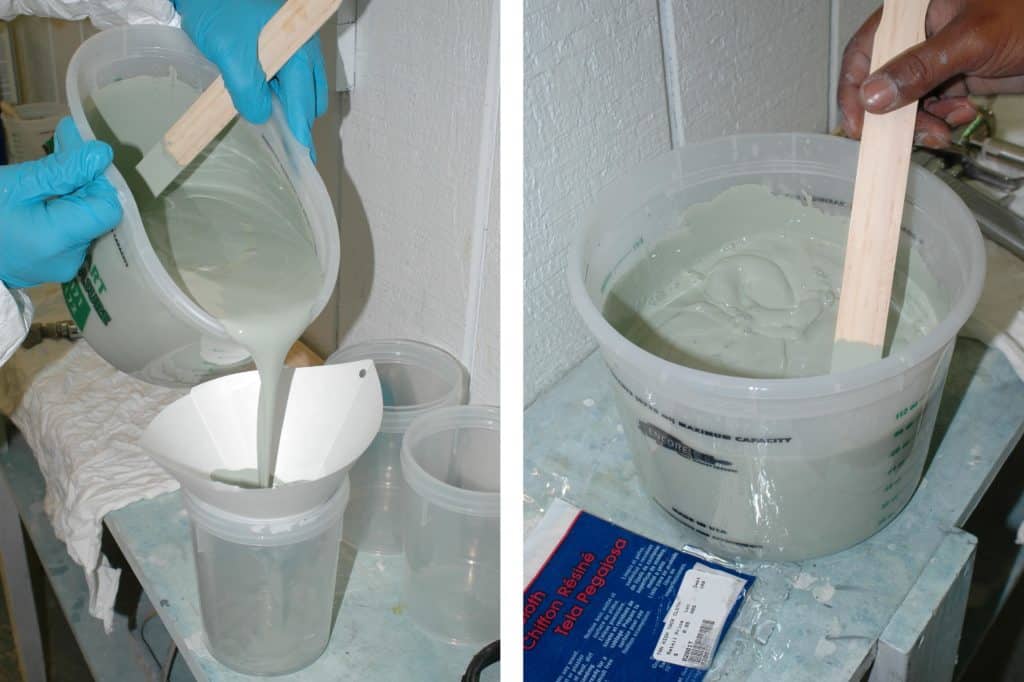
Preparation and Application
What do you intend to paint, and what is its condition? The answers to those questions drive some element of the preparation process. Wood, steel, aluminum, gelcoat or an existing coating each requires a different type of preparation (and more detail than can be covered here). Fortunately, paint manufacturers want satisfied customers and go to great lengths to provide detailed instructions for both preparation and application for all types of surfaces. Before picking up a brush or stirrer, read the literature provided by the manufacturer of the paint you are preparing to use.
In general, though, begin by cleaning the surface and removing all traces of dirt, debris, dust, previous loose coatings and, above all else, wax and oil. Where failed paint applications are concerned, the latter two contaminants are likely the most culpable; they steadfastly repel coatings, leaving behind the dreaded “fish eye,” a small oval “paint desert” that’s guaranteed to ruin any painter’s day.
Surfaces should be washed with fresh, soft water and mild detergent (detergent and diluted ammonia is an effective cleaning agent, and bleach should be used if mildew is present, but never mix the two). Next, de-wax the surface using a clean rag that has been rinsed in fresh water to remove any trace of detergent or surfactant, allow it to dry, and then dampen it with solvent such as denatured alcohol (again, following the paint manufacturer’s instructions) or mineral spirits. The rag should be frequently turned to expose a new face and discarded as soon as it’s completely soiled.
A tack rag, a proprietary product that looks and feels like a slightly sticky gauze bandage, should then be used to wipe down the entire surface to remove all traces of dust. Some applicators use compressed air to blow dust off the surface. But beware: Compressors can contaminate the air supply with trace amounts of oil, which, as mentioned above, can wreak havoc on a finish. Compressed-air oil filters are available and should be used if you intend to blow off a surface at any point during the painting process.
An adhesion test should be carried out before applying two-part paint over an existing two-part coating. Nobody wants to expend significant effort to apply as perfect a finish as possible, only to have the original coating release from the substrate, which often occurs when masking tape is removed. A visual inspection will be your first indicator; if paint is flaking in any way, then it probably should be condemned.
The next test is more definitive and should be carried out after cleaning and de-waxing. Deeply score the surface (down to the substrate) with a sharp razor blade in a small checkerboard pattern (six vertical and six horizontal lines, approximately 2 inches square). Apply filament-type packing tape diagonally across the box, and then abruptly yank it off parallel to the surface. If any of the squares remain stuck to the tape, the test has failed, and all of the existing paint down to the sound substrate or the virgin surface should be removed.
If the coating passes the initial tests, the next evaluation involves solvent compatibility to ensure the new paint does not cause an adverse reaction by lifting, bubbling and so on. Saturate a cotton ball with the reducer that will be used to thin the applicable paint, apply the cotton to the scribed area, tape it in place, and leave it for 30 minutes. Remove the cotton. If the reducer dissolves or markedly softens the existing coating, all of the paint must be removed before the new two-part paint is applied.
Paint primer — the coating applied after the surface has been prepared but before applying a final or topcoat — is a science unto itself. Primers primarily fall into two categories: oil or enamel, and epoxy-based. The overarching rule where primer is concerned is compatibility with both the surface over which it is applied and, most importantly, with the topcoat that will be applied over it. With very rare exceptions, primer should be sourced from the same manufacturer as the topcoat, and even in those instances, you must still ensure compatibility.
Epoxy has a reputation for adhering tenaciously to virtually anything except oil and wax. It has poor UV resistance, which makes it ideally suited as a primer, as the topcoat will cover and protect it from the sun’s damaging rays. Most epoxy primers are two-part, adding complexity to the application process; they remain the primer of choice, however, particularly with two-part topcoats.
While it’s not absolutely necessary to use a primer for every paint application, you should once again defer to the coating manufacturer’s instructions. Most paint companies recommend the use of a primer for virgin wood, gelcoat, fiberglass and bare metal. The latter typically requires what’s known as an etching primer; it’s slightly acidic and primes the surface as well as chemically profiling it, improving adhesion.
Nearly all paint manufacturers also establish protocols regarding temperature, prohibiting application if the air or substrate temperature is too low (40 degrees F is a typical low threshold). All LPU and many enamel paints cannot be used in areas where they will be continually submerged, such as below the waterline or in wet bilges. Doing so will result in osmotic plastering and general adhesion failure. For those applications, an epoxy-based paint, ideally one designed especially for bilges, should be used.
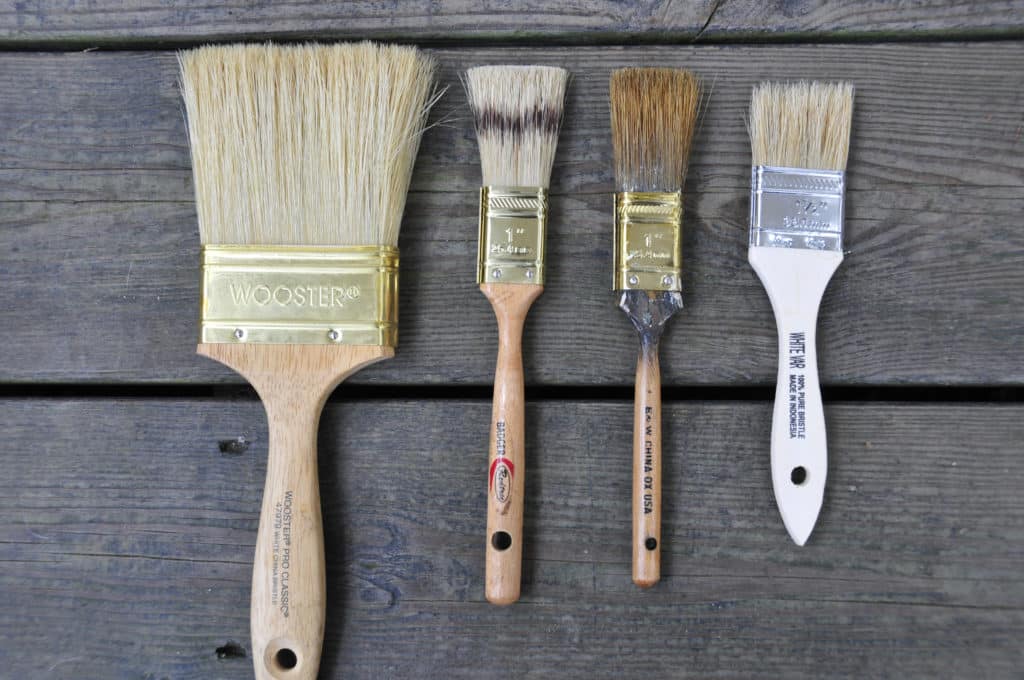
The Painter’s Tools
Quality hand tools, sockets, wrenches, cutters and strippers make engine and electrical work go more smoothly and yield professional results, and the same can be said of paintbrushes. Walk into any chandlery, and it’s easy to be confused by the selection: synthetic versus natural fiber; square, angled, chiseled (or not); and round or paddle handles.
Where enamel and two-part topcoats are concerned, my preference is for natural-bristle brushes with a chisel-shaped tip. Unlike synthetic fibers, which can melt if exposed to the wrong materials, natural bristles are immune to solvents, acids and other chemicals. Synthetic-fiber brushes are typically used with water-based paints, where natural bristles become sodden and perform poorly. The chisel-shaped tip (as opposed to a round tip) is designed to leave behind a smooth finish while minimizing stroke marks.
Natural brushes are frequently known as “China bristle” because the vast majority are made from Chinese hog hair. These have a desirable feature known as a “flagged tip”; a bit like a human hair’s split ends, these tips are flatter and wider than the remainder of the bristle, helping them retain more paint. The brush cross-section should be oval; it too retains more paint and is well suited to broad application surfaces. Make certain that the brush’s ferrule — the metal band that retains bristles — is tight and made of stainless steel. Quality brushes should rarely shed. Inexpensive, disposable China-bristle brushes, often known as “chip brushes,” are fine for bottom paint or other nontopcoat applications, but they are notorious for dropping bristles.
If you seek the highest possible quality for your brushes, and the finish they deliver, then move up to ox and badger hair. The latter is my preference for varnishing and when “rolling and tipping” — the practice of applying paint first with a roller and then brushing it out, a commonly used technique for two-part paint applications on hulls and other large surfaces. These natural-bristle brushes yield the smoothest flow and hold paint exceptionally well. Rollers, if used for rolling and tipping, must of course be compatible with the paint, and must be of the short-nap variety to minimize irregularity in the coating application.
Paint is an area where a do-it-yourselfer can achieve high-quality results, provided he or she follows the aforementioned tips as well as the coating manufacturer’s instructions. Practice, of course, is always recommended; the more time you spend with a brush in hand, the better the results.
Steve D’Antonio offers services for boat owners and buyers through Steve D’Antonio Marine Consulting (stevedmarineconsulting.com).
- More: DIY , How To , paint , Refits , Upgrades
- More How To

3 Clutch Sails For Peak Performance

It’s Time to Rethink Your Ditch Kit

8 Ways to Prevent Seasickness

How To De-Winterize Your Diesel Engine

Bitter End Expands Watersports Program

Sailboat Review: Tartan 455

Miracle in a Bowl

Cole Brauer Completes the Global Solo Challenge
- Digital Edition
- Customer Service
- Privacy Policy
- Email Newsletters
- Cruising World
- Sailing World
- Salt Water Sportsman
- Sport Fishing
- Wakeboarding

Boating Basics Online is reader-supported. When you buy via our links, we may earn a commission at no cost to you. Learn more
How to Paint a Sailboat? – A Step-by-Step Guide
Written by J. Harvey / Fact checked by S. Numbers

Painting a sailboat hull not only lets you save money, but it can also be quite gratifying. Plus, learning how to paint a sailboat can be likened to taking that one important step of truly claiming your vessel as your own. I mean, they’re our darlings, right?
This simple guide teaches you how to paint the hull of a boat, including a sailboat’s. Overall, it’s not hard to grasp – just a bit tiring, and plenty of waiting is involved.
Table of Contents
Prepare the Following
Step 1. give the sailboat a thorough cleaning., step 2. start sanding the hull’s surface., step 3. prepare the primer, then apply it., step 4. prepare the paint, then start applying the topcoat and antifouling coat., the importance of painting your sailboat, how often do i need to paint my sailboat, some best paints to use for a sailboat, safety tips for painting.
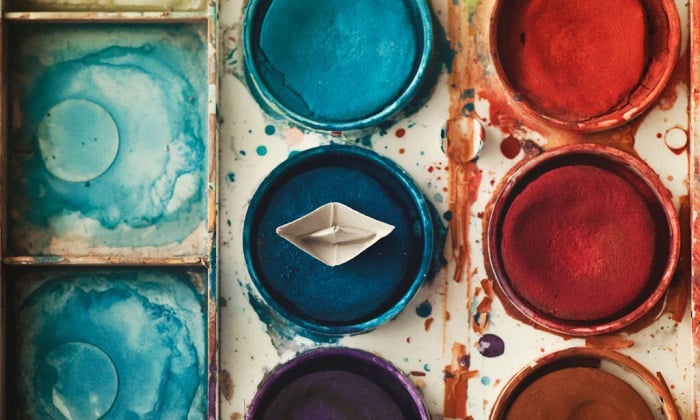
- Marine-grade paint
- Primer (epoxy recommended) and hardener
- Sandpaper (80-grit, 220-grit, and 400 grit)
- Cleaning cloth
- Masking tape
- Roller (or paint sprayer)
- PPEs such as gloves, a coat, and a respirator
Choose a workspace with good ventilation to avoid exposing yourself to fumes, which have many detrimental but highly avoidable side effects. Painting the boat on its trailer on a clear, dry day and positioning it so the paint won’t get direct sunlight exposure are ideal.
Practical Steps for Painting a Sailboat
This guide works well for fresh paint jobs and even if you’re repainting the boat.

Any dirt, debris, and grease should be taken care of in any sailboat paint job. Check for debris and algae clinging to the hull and the sailboat deck, and just use the brush and cloth to get it off.
Double-check parts of the keel because mud and seaweed tend to stick to it the most. If there are barnacles present, you may have to power wash them or any stubborn green stuff you encounter.
Dip the sponge in a mix of boat soap and water, then start scrubbing any stains. Afterward, give the sailboat a good rinse. Wait for it to dry.
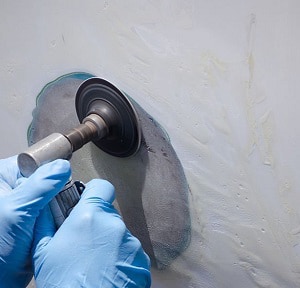
Put on your respirator and coat. Use an 80-grit or 100-grit to roughen the surface and remove any lingering trace of old paint by scrubbing in circular motions.
Then, grab the 220-grit to smoothen the surface more. That said, an 80-grit or 40-grit paired with a sander will do just as well, based on my experience every time I repaint a fiberglass boat .
You’d want the surface to be as even and smooth as possible before applying the first coat.

The epoxy primer helps to ensure that the paint will adhere well, too, so I recommend you don’t skip it. Epoxy also acts as a good sealant and prevents cracking and rust.
Before you apply it, put some masking tape over the areas of the hull that you don’t want the coats to go over. It will ensure even coats, too.
Every epoxy primer and hardener combination is different in one way or another. As such, follow what the manufacturer recommends when mixing. Be mindful of how quickly the mixture hardens.
Once you’re done with that step, use the roller to apply even coats of it over the whole surface of the hull. Depending on the size of your boat, this may take a while and can be tiring, so I suggest you ask for help.
Done? It’s time to wait a day to apply another layer. The next day, you can either apply another coat of primer (up to 4 coats is great) or proceed to the painting part.

Mix the paints according to the instructions.
You need to make sure the primer has dried before painting. I suggest two layers of topcoat followed by two equal coats of antifouling paint. But you can also skip to the antifouling paint immediately – your boat, your choice.
- Be sure to pick a good marine-grade paint like TotalBoat’s Alumipaint AF or Interlux’s Fiberglass Bottomkote Aqua. Better yet, you can just head to your local marine shop and ask for recommendations (trust me, they know their sailboat paint best).
- We’re not exactly doing something artsy here, like making an easy sailboat painting with acrylics. You want coats that can take a beating, so choose marine grade only.
Once you’re ready to work, use a roller or a sprayer to apply the paint. Personally, I’d suggest the latter choice because if you spray paint a boat, you’ll get a sleeker, more attractive finish, although it requires some skills.
Therefore, if you’ve never handled a sprayer, the best way to paint a boat would be with a roller. Here are some tips to ensure the best results:
- Pour the paint into the t
- Slightly dampen the roller with clean water.
- Lightly dip the roller into the paint so that no more than half of it is submerged.
- Run the roller on the paint tray’s ramp a few times to evenly distribute the pigment.
- Run the roller from the top to the bottom of the hull. Make sure you apply even pressure as you do so. Remember: the strokes should be parallel and uniform; under no circumstance should you change the stroke to a different pattern.
- Use a paintbrush to access cavities and holes on the hull that your roller can’t reach.
- Apply the suggested number of coats for each type of paint, taking care to sand with the 400-grit or higher with each However, make sure you confirm that it’s recommended by the paint’s manufacturer.

- The first is aesthetics. How can your gaze possibly not be arrested by an exquisitely painted sailboat sailing in the distance? It’s an automatic postcard image.
- Secondly but just as important (if not more), you’re protecting your baby from damage, barnacles, rot, and other nasty things, extending its life and boosting its value.
- It exercises your creativity. Try out some sailboat paint schemes available on sites like Pinterest, and you’ll know what I’m talking about.
I’ve certainly tried one or two of these ideas myself, but not on a skiff and jon boat that I made from scratch. My wife and buddies were positively mesmerized.
- Much like how videos on YouTube showing easy boat acrylic painting puts my mind at ease, I can say the same for when I’m painting sailboat hulls.
A lot of my friends who love to sail, fish, and paint sailboats on canvas say the same since they’re often more than willing to stop by and lend a helping hand during my paint days. We exchange sailboat painting ideas occasionally, and they like the method I’ve shared here.
As such, painting boats can be a way to relax your mind and help you connect with like-minded people. You may also learn helpful tips regarding sailing and boat maintenance along the way.
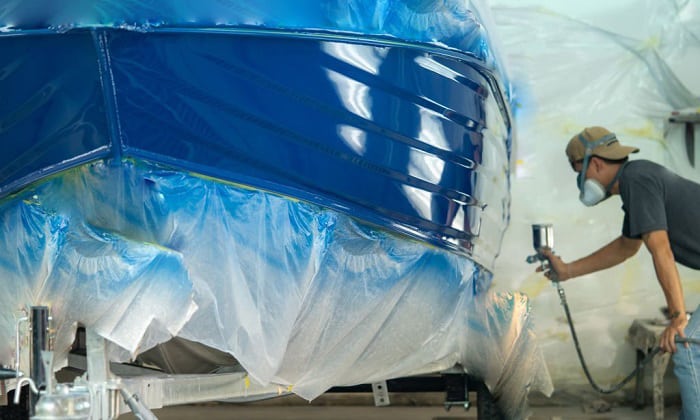
You need to paint your boat every year if you let it sit in the water all the time and the vessel shows signs of degradation.
That said, if you paint your sailboat with high-quality products, such as marine-grade paint, the coating can last for as long as 10 years, especially if you’re extra careful with your boat and have proper storage for it.
Besides the two brands I mentioned above, you can also try antifouling paints by Rust-Oleum. I just rotated between TotalBoat, Rust-Oleum, and Interlux because these three provided the best results among the sailboat paints I tested.
Rust-Oleum’s Topside Paint paired with the brand’s fiberglass primer work well with fiberglass hulls. But I can say the same for TotalBoat’s Topside Paint. To me, it’s really just whichever of the three is available on my local marine shop’s shelf. Besides choosing the right paint, you may also ask yourself how much it costs to paint a boat. Is it worth it? Check out this article to get the answer!
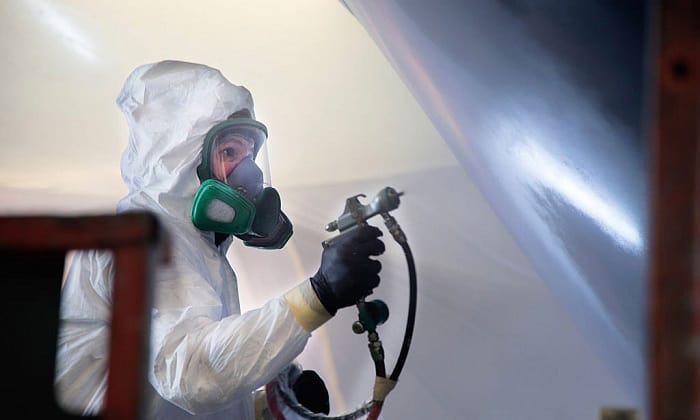
If you follow most of the preliminary preparatory steps I’ve shared here, you will be keeping yourself safe from start to finish.
- Wear the PPEs I said above every time you’re sanding and applying epoxy and paint on the surface.
- Read any warning labels on the paint and other chemicals you use, like acetone for drying the paint quickly. Handle it with care always.
- Learn how to dispose of your paint properly. It’d be even better if you learned how to recycle it.
- Beware of accidents that may happen while you’re doing the cleaning and prep work. I mean, I’ve hit my head on a sailboat mast while doing them, so I reckon the chance of such misfortunes happening isn’t zero, even on a paint job.
To recap everything I’ve said regarding how to paint a sailboat:
- Position your boat in a good workplace.
- Clean and sand its hull well using boat soap and water and sandpaper.
- Apply 4 coats of the primer, 2 coats of the topcoat, then 2 antifouling coats, or skip to the antifouling paint coat immediately.
- Decide how you’re going to apply the paint based on the finish you want and your skill in using each tool.
We wish you the best of luck with your painting project. If you want to share your results with us, feel free to reach out via the comment below.

“My intention from the first day establishing Boating Basics Online is to provide as much help as possible for boaters who want to experience a first safe and convenient trip. So feel free to join us and share your beautiful journeys to the sea!”

Service Locator
- Angler Endorsement
- Boat Towing Coverage
- Mechanical Breakdown
- Insurance Requirements in Mexico
- Agreed Hull Value
- Actual Cash Value
- Liability Only
- Insurance Payment Options
- Claims Information
- Towing Service Agreement
- Membership Plans
- Boat Show Tickets
- BoatUS Boats For Sale
- Membership Payment Options
- Consumer Affairs
- Boat Documentation Requirements
- Installation Instructions
- Shipping & Handling Information
- Contact Boat Lettering
- End User Agreement
- Frequently Asked Questions
- Vessel Documentation
- BoatUS Foundation
- Government Affairs
- Powercruisers
- Buying & Selling Advice
- Maintenance
- Tow Vehicles
- Make & Create
- Makeovers & Refitting
- Accessories
- Electronics
- Skills, Tips, Tools
- Spring Preparation
- Winterization
- Boaters’ Rights
- Environment & Clean Water
- Boat Safety
- Navigational Hazards
- Personal Safety
- Batteries & Onboard Power
- Motors, Engines, Propulsion
- Best Day on the Water
- Books & Movies
- Communication & Etiquette
- Contests & Sweepstakes
- Colleges & Tech Schools
- Food, Drink, Entertainment
- New To Boating
- Travel & Destinations
- Watersports
- Anchors & Anchoring
- Boat Handling
- ← Maintenance
Applying Bottom Paint
Advertisement
Preparation required for a successful bottom job begins as soon as the hull clears the water.

Slime and growth are relatively easy to remove while the bottom is still wet, but let the stuff dry and you will have to chisel it off. Fortunately most boatyards pressure wash the bottom as soon as they haul the boat, and many will also knock off hard growth with a long-handled scraper. If bits of bottom paint flake off under the pressure of the washer nozzle, ask the yard worker to make another pass to remove as much loose paint as possible.
Remember that the adhesion of the new paint is only as good as that of the paint under it, so watch for signs of adhesion failure. Anywhere the old paint is flaking or lifting, worry exposed edges with a knife or small chisel. If the paint zips off, the bottom needs to be stripped.
You may also have to strip the bottom if you are changing the type of paint. For example, the aggressive solvents in vinyl paints lift other types of bottom paints, so if you are applying vinyl, any non-vinyl paint has to come off. And soft, sloughing paints are a poor undercoat for anything other than a fresh coat of the same.
Using a 2-inch hook scraper is the stripping method least injurious to both you and the planet, and this is often the easiest method as well. If you decide to use a chemical stripper, be sure it is one formulated for fiberglass; regular strippers will attack the gelcoat.
When the old paint is in good condition, in general you need only sand it, wash it, tape the waterline, and roll on a fresh coat or two. A grinder loaded with 80-grit disks on a foam pad can quickly prepare a hull for recoating, but it can also chew through the paint and into the laminate in an instant. If you lack experience with this powerful tool, 80-grit paper in a random orbit sander or a finishing sander will do the same job somewhat less quickly but with much less risk to the hull. Do not use a belt sander; it is designed to make things flat and that is the effect it will have on your hull.
Many boatyards now prohibit normal power sanding because of the dust it generates. The solution is a shop-vac and a random-orbit sander with a vacuum hose connection. If you don't want to buy a new sander, slip a length of plastic hose over the dust bag mount on your old palm sander and tape the other end into the shop-vac hose. Either rig will capture most of the toxic dust sanding generates, but not all of it. Be sure to wear a tight-fitting respirator — not a paper mask — while sanding. Also wear earplugs to shut out the din of the sander and the vac. You'll save your hearing and find the work much less tiring.
Even if you aren't stripping the bottom, it is good practice to sand away most of the previous application. This avoids a thick build-up that will eventually turn brittle and cause new paint to flake. A different color first coat provides a flag that signals when you have sanded enough.
Bare Fiberglass
A hull that has not been previously painted has mold release wax on the fiberglass that will interfere with paint adhesion unless you remove it. Clean the hull surface thoroughly with dewaxing solvent and plenty of clean rags before you sand; otherwise sanding drags the wax into the scratches and it will be that much harder to remove.
Sand the de-waxed hull lightly with 80-grit paper before applying the first coat of paint — the flag coat — which should be a different color from the top coat(s).
If the boatyard has a paint shaker, run it for at least 5 minutes to get the copper and the pigment evenly distributed throughout the paint. A drill-powered mixing paddle can also do a good job. In the absence of a either, pour half the paint into a mixing bucket so you can mix the remaining half vigorously without sloshing paint onto the ground. Keep dredging up the copper off the bottom of the can until the bottom feels clean to the touch of your paddle. Slowly stir in what you poured off until the paint is uniform in color and consistency. If the paint has been on the shelf awhile, getting it mixed thoroughly can take 10 or 15 minutes, but don't skimp; if the copper isn't evenly distributed, some areas of your hull won't be protected.
Roll the paint onto the hull using a short-nap roller cover. An extension for the handle will make painting the keel easier and keep you clear of the inevitable droplets the roller will sling. Wear sleeves and gloves to keep the paint off your skin.
Don't add any thinner to bottom paint unless the manufacturer specifies otherwise. (There are exceptions to every rule: thinner may be required if the day is hot and windy.)
Fill the basin of your paint tray with paint. Dip your roller, unload it on the tray slope, and roll it up and down on the hull, i.e. from waterline to keel. Work fast as many bottom paints dry quickly. Each time you refill the paint tray, first stir the paint in the can to keep the copper in suspension.
By the time you work all the way around the hull, many bottom paints will be dry enough to overcoat. Check the specifications on the paint you are using. A second coat lengthens the life of almost any bottom paint; copolymers benefit from 3 or 4 coats. No sanding or other prep is needed between coats. Save some paint for the areas under the stand or cradle pads.
Get the yard manager to move the stands as soon as the rest of the hull is dry (never move stands yourself!), and put rags or sheet plastic on the pads to protect your new paint. Prep the bare spots and apply the appropriate number of coats. Save a little paint to slap on the areas on the bottom of the keel you can't get to until the boat is lifted.
Prop and Shaft
You can paint the prop if you like, but copper-based paint won't stay on a bronze prop (nor bronze rudders and struts) for long. Prop paints are available, but demanding prep — up to four prime coats — discourages their use. A heavy coat of wax on the prop will keep it clean for a time.
Don't paint the shaft, and be sure you leave all anodes unpainted. If you are installing new anodes — a good idea — make certain you don't paint over their mounting locations. Good electrical contact is essential for anodes to do their job.
Let bottom paint dry at least overnight before you put masking tape on it to paint the bootstripe. Get hard bottom paint into the water within the time specified on the label.
For more information about painting, consult Sailboat Refinishing by Don Casey
Related Articles
The truth about ceramic coatings for boats.
Our editor investigates the marketing claims of consumer-grade ceramic coatings.
Fine-Tune Your Side Scan Fishfinder
Take your side-scanning fishfinder off auto mode, and you’ll be spotting your prey from afar in no time
DIY Boat Foam Decking
Closed-cell foam flooring helps make boating more comfortable. Here’s how to install it on your vessel
Click to explore related articles
Contributor, BoatUS Magazine
Don Casey has been one of the most consulted experts on boat care and upgrades for 30 years, and is one of the BoatUS Magazine's panel of experts. He and his wife cruise aboard their 30-footer part of the year in the eastern Caribbean. His books include Don Casey's Complete Illustrated Sailboat Maintenance Manual, and the recently updated This Old Boat, the bible for do-it-yourself boaters.
BoatUS Magazine Is A Benefit Of BoatUS Membership
Membership Benefits Include:
Subscription to the print version of BoatUS Magazine
4% back on purchases from West Marine stores or online at WestMarine.com
Discounts on fuel, transient slips, repairs and more at over 1,200 businesses
Deals on cruises, charters, car rentals, hotel stays and more…
All for only $25/year!
We use cookies to enhance your visit to our website and to improve your experience. By continuing to use our website, you’re agreeing to our cookie policy.

Step-by-Step Guide: How to Paint a Sailboat with Acrylics
Alex Morgan

Painting a sailboat with acrylics can be a rewarding and enjoyable artistic endeavor. Whether you are a beginner or an experienced artist, this article will provide you with a comprehensive guide to creating a stunning sailboat painting using acrylic paints.
To begin with, you will need specific materials and tools to ensure a successful painting process. These include acrylic paints in various colors, a set of brushes suitable for acrylic painting, a palette for mixing colors, a canvas or painting surface, a water container for cleaning brushes, a palette knife for texture, and a reference image or sketch of a sailboat.
Before you start painting, it is essential to prepare the surface properly. This involves cleaning the surface to remove any dust or debris, and then applying a layer of primer or gesso to create a smooth and even base for your paint to adhere to.
To achieve the desired result, it is important to understand and practice basic techniques for painting with acrylics. This includes learning how to mix colors to create different shades and tones, how to layer and blend colors to add depth and dimension, and how to create texture and detail in your sailboat painting.
Once you are familiar with the techniques, you can follow a step-by-step guide to painting a sailboat. This includes sketching the sailboat outline, blocking in the background colors, adding base colors to the sailboat, adding details and highlights, and refining the painting to ensure a polished and professional look.
To complete your sailboat painting, don’t forget the finishing touches and sealing the artwork to protect it and enhance its longevity. We will share some tips and tricks to help you master the art of painting a sailboat with acrylics, allowing you to express your creativity and create beautiful marine-inspired artworks. So gather your materials and get ready to set sail on your artistic journey!
Key takeaway:
- Using acrylic paints and appropriate tools is essential for painting a sailboat. Acrylic paints are versatile and easy to work with.
- Properly preparing the surface by cleaning and applying primer or gesso ensures a smooth painting surface.
- Understanding basic techniques such as color mixing, layering, blending, and creating texture and detail is important for painting a realistic sailboat.
- Following a step-by-step guide helps in achieving a well-executed sailboat painting.
- Finishing touches and sealing the painting enhance its longevity and protect it from damage.
- Tips and tricks such as using reference images or sketches and refining the painting contribute to a successful acrylic sailboat painting.
Materials and Tools Needed for Painting a Sailboat
Are you ready to set sail on a creative painting journey? This section has all the juicy details about the materials and tools needed to paint a stunning sailboat with acrylics. We’ll dive into the vibrant world of acrylic paints , the magic touch of different brushes , the perfect palette for mixing colors, the ideal canvas or painting surface, the essential water container and palette knife , and the importance of having a reference image or sketch. Get your creative gears ready, because we’re about to embark on an artistic adventure !
Acrylic Paints
When painting a sailboat with acrylic paints , it is crucial to choose the right type of acrylic paint . Consider the following factors when selecting acrylic paints :
– Quality : Opt for high-quality acrylic paints for vibrant and long-lasting colors.
– Color range : Look for brands that offer a wide range of colors, including various shades of blue for painting the sky, water, and sails of the sailboat.
– Opacity : Consider the opacity of the acrylic paints . Some colors are more opaque, allowing for solid coverage, while others are more transparent, allowing for layering and glazing techniques.
– Drying time : Check the drying time of the acrylic paints . Faster drying paints are great for quickly building layers, while slower drying paints allow for more blending and wet-on-wet techniques.
– Brand reputation : Research and choose acrylic paints from reputable brands known for their quality and consistency.
Pro-tip : Before starting your painting, it’s recommended to do a small color swatch test to see how the colors appear on your chosen canvas or painting surface. This will help you make any necessary adjustments before committing to the final artwork.
When painting a sailboat with acrylics, the right brushes are crucial for achieving desired results. Here is a list of brushes to consider:
1. Round brushes: Perfect for creating fine details like rigging and small waves. They come in various sizes, from small for intricate work to larger for broader strokes.
2. Flat brushes: Ideal for creating straight lines and sharp edges. Great for painting sails, the horizon, or other flat surfaces on the sailboat.
3. Fan brushes: Excellent for creating texture like foliage or water splashes. Can also blend colors and create soft, feathery strokes.
4. Filbert brushes: Versatile brushes for both fine details and broader strokes. Particularly useful for painting the hull and larger areas.
5. Detail brushes: Perfect for adding intricate details and highlights. Allows for precise control in adding fine lines, textures, and highlights.
Fact: Using the right brushes not only makes painting a sailboat easier but also enhances the overall quality of your artwork. Experimenting with different brush shapes and sizes can help achieve different effects and add depth to the painting.
When painting a sailboat with acrylics , a palette is essential for effectively mixing and organizing colors. A palette serves as a flat surface where you can arrange and blend paints.
Canvas or Painting Surface
Choosing the right canvas or painting surface is crucial for a successful sailboat painting with acrylics. The size and material of the canvas are important factors that affect the outcome of the painting.
A larger canvas allows for more details and a grander composition, while a smaller canvas is more manageable and quicker to complete. The most popular canvas materials are cotton , linen , and polyester .
Cotton canvas is affordable and suitable for beginners. Linen canvas , though more expensive, offers a smoother surface and better longevity. Polyester canvas is a synthetic option that is resistant to moisture. Regardless of the material you choose, it is important to prime the canvas with gesso or primer before painting.
This creates a smooth and stable surface for the acrylic paints, resulting in better color vibrancy and a longer-lasting artwork. When selecting a canvas or painting surface, consider your artistic vision and preferences to create a stunning sailboat painting with acrylics.
Water Container and Palette Knife
The sub-topic “ Water Container and Palette Knife ” in the article “ How To Paint A Sailboat With Acrylics ” can be represented in a table format:
Using a water container is essential in acrylic painting to keep your brushes clean and prevent paint from drying. The container should be filled with clean water and changed when dirty to ensure a constant supply of clean water for rinsing and thinning paint.
The palette knife is a versatile tool for mixing colors directly on the palette. Its flat blade is perfect for scraping and lifting paint, allowing for experimentation with color combinations and creation of various textures in artwork. The palette knife can be used to apply paint directly to the canvas for precise and controlled brushwork.
By having a water container and palette knife in your painting toolkit, you’ll be equipped to efficiently and creatively work with acrylic paints, bringing your sailboat painting to life.
Reference Image or Sketch
When painting a sailboat with acrylics, having a reference image or sketch is crucial for accuracy and capturing the essence of the subject. The reference image serves as a visual guide, helping artists understand the structure, proportions, and details of the sailboat.
To create a reference image or sketch, start by selecting a clear and high-resolution photograph of the sailboat. It should showcase the desired angle and composition for the painting. Then, use a pencil or grid method to transfer the main outlines and important features onto your canvas or painting surface.
The reference image or sketch acts as a roadmap throughout the painting process. It helps artists determine the placement of the sailboat, the position of the sails, the shape of the hull, and other details. By referring to the image or sketch, artists can ensure accuracy and achieve a realistic representation of the sailboat.
Remember to use the reference image or sketch as a guideline rather than strictly copying it. Allow yourself to add your own artistic interpretation and style to make the painting unique. Experiment with colors, textures, and brushwork to bring the sailboat to life on your canvas.
With a well-prepared reference image or sketch, artists can confidently paint a sailboat with acrylics, capturing its beauty and spirit in their artwork.
Preparing the Surface for Painting
Preparing the surface is a crucial step in painting a sailboat with acrylics . In this section, we’ll discover the necessary techniques to ensure a smooth and long-lasting finish. First, we’ll explore the importance of cleaning the surface thoroughly. Then, we’ll dive into the significance of applying primer or gesso before starting the actual painting process. These essential steps will set the foundation for a successful sailboat painting adventure. So let’s get our brushes ready and make that canvas shine!
Cleaning the Surface
When preparing to paint a sailboat with acrylics, it is essential to follow these important steps for cleaning the surface:
1. Begin by using a soft brush or cloth to remove any dust or debris from the surface. This step is crucial for ensuring proper adhesion of the paint.
2. In case there are stains or dirt that cannot be removed using a brush, gently clean the area with mild soap and water. It is important to avoid harsh chemicals as they may cause damage.
3. Prior to painting, it is necessary to eliminate any peeling or flaking paint. This can be done by carefully smoothing the surface using sandpaper or a scraper.
4. After the cleaning and preparation process, it is recommended to apply a layer of primer or gesso. This will create a smooth surface, enhancing color saturation and durability.
Remember to take your time and handle the surface gently during the cleaning process to prevent any damage. Properly cleaning and preparing the surface guarantees a beautiful painting that will last for a long time.
Applying Primer or Gesso
Applying primer or gesso is necessary for preparing the surface before painting a sailboat with acrylics . It creates a smooth base for the paint, improving the quality and durability of the artwork.
To apply primer or gesso:
- Clean the surface: Remove dust, dirt, and grease using a soft cloth or brush.
- Choose the right primer or gesso: Use acrylic gesso , which dries quickly and works well with acrylic paints.
- Prepare the primer or gesso: Stir it thoroughly and thin with water if needed, following the manufacturer’s instructions.
- Apply the primer or gesso: Use a brush or palette knife to apply an even layer, covering the entire area to be painted.
- Allow drying time: Let the primer or gesso dry completely, which usually takes 1-2 hours, but may vary based on the product and environment.
Applying primer or gesso creates a strong foundation for your sailboat painting, ensuring vibrant colors and good adherence to the surface. It also prevents unwanted paint absorption into the canvas or other surfaces. Follow the manufacturer’s instructions for best results.
Understanding Basic Techniques for Painting a Sailboat
Discover the vibrant world of sailboat painting as we delve into the fundamental techniques that bring these majestic vessels to life. From mixing colors to layering and blending, and even creating texture and detail, we’ll explore the artistry and skill required to capture the essence of a sailboat on canvas. Get ready to embark on a creative journey as we unlock the secrets of painting a sailboat with acrylics !
Mixing Colors
When mixing colors in acrylic painting, there are techniques to achieve the desired result.
– Start with the primary colors : red, blue, and yellow. These are the foundation for all other colors.
– Use a color wheel to understand color relationships. Opposite colors on the wheel, such as blue and orange, create contrast when mixed.
– Experiment with different color ratios to create shades and tints. Adding more blue to yellow creates a green shade , while adding more yellow to blue creates a green tint .
– Gradually add small amounts of one color to another, mixing and blending until the desired hue is achieved.
– Consider the effect of adding white or black to a color. Adding white creates a lighter shade , while adding black creates a darker shade .
– Take note of the drying time of acrylic paints, as the color may slightly shift once dry. Let the mixed colors dry before making adjustments.
– Clean brushes thoroughly between color mixing to avoid contamination and achieve accurate colors.
By understanding these mixing techniques, you can confidently create a wide range of colors for your sailboat painting. Experiment and explore different combinations to achieve unique and vibrant results.
Layering and Blending
Layering and blending are pivotal techniques in the realm of acrylic painting. Employ the following strategies to attain the desired effect:
– Emphasize layering: Begin by applying thin coats of paint and gradually intensify the color and texture in order to exercise better control over the varying shades and values.
– Master the art of wet-on-wet blending: Meld hues by applying wet paint atop another still wet layer, resulting in seamless transitions and smooth gradients.
– Harness the power of dry brushing: Utilize a minimal amount of paint with a dry brush to fashion texture and highlights, which is ideal for incorporating intricate details.
– Embrace glazing: Introduce translucent layers of paint onto dry layers to yield depth and radiance, thereby permitting subtle variations in color and an atmosphere-like aura.
– Achieve blending with a palette knife: Directly mix and blend colors on the painting surface using a palette knife, imbuing the artwork with texture and dimension.
Experiment with these techniques to ascertain the most effective approach. The combination of layering and blending can augment the depth, dimension, and opulence of your acrylic paintings, thereby enabling you to create captivating sailboat masterpieces.
Creating Texture and Detail
Creating texture and detail is essential when painting a sailboat with acrylics . These techniques enhance the depth and visual interest of the artwork. To achieve texture, it is recommended to utilize methods such as dry brushing , sponging , or palette knife strokes.
Implementing these techniques effectively can add texture not only to the sails , water , but also to the boat as a whole.
One approach to create texture on the sails is by using the dry brush technique. This involves applying a small amount of paint to a dry brush and gently brushing it onto the canvas. By doing so, a rough and textured appearance is achieved, giving the impression of fabric on the sails. To replicate waves and ripples on the water, consider using a palette knife to apply thick, undiluted paint with a scraping motion.
Adding intricate details is crucial in bringing the sailboat to life. Using fine brushes and thin paint, you can incorporate intricate elements such as rigging , ropes , and various features on the boat. Paying close attention to these details will greatly enhance the realism and overall quality of the painting.
Don’t be afraid to experiment with different techniques and brushes in order to achieve the desired textures and details. Remember, practice and patience are key when mastering the art of creating texture and detail in sailboat paintings.
Fun Fact: Incorporating texture and detail in a painting can give the artwork a three-dimensional appearance, captivating viewers.
Step-by-Step Guide to Painting a Sailboat
Master the art of painting a sailboat with acrylics with this step-by-step guide.
We’ll take you through the process, from sketching the sailboat to refining the final touches.
Discover how to block in the background, add base colors, and bring your sailboat to life with details and highlights.
With these expert tips and techniques, you’ll be able to create a stunning sailboat painting that showcases your artistic skills.
Get ready to embark on a creative journey and immerse yourself in the world of sailboat artistry.
Sketching the Sailboat
To begin sketching the sailboat before painting with acrylics, follow these steps:
1. Take a blank canvas or painting surface.
2. Take a look at the reference image or sketch of the sailboat.
3. Recognize the basic shapes and proportions of the sailboat, including the hull , sails , and mast .
4. Use a pencil or charcoal to create a light outline of the sailboat on the canvas. Begin with simple shapes and lines.
5. Pay close attention to the positioning and size of various elements, such as the sails and the angle of the mast.
6. Add more intricate details to the sketch, such as windows, ropes, or flags. It is important to ensure accurate proportions and perspectives.
7. Erase any unnecessary lines or mistakes while refining the sketch. Focus on capturing the overall shape and composition.
8. Once you are satisfied with the sketch, go over the lines with a fine-tipped pen or marker to define them. Alternatively, you can use a dark pencil.
9. Review the sketch to make sure it accurately represents the sailboat and the desired composition.
10. The sketch is now ready to serve as a guide for painting the sailboat with acrylics.
By following these steps, you can create a detailed and accurate sketch of a sailboat before starting the painting process.
Blocking in the Background
Blocking in the background is an important step in painting a sailboat with acrylics. It establishes the composition and sets the tone for the rest of the painting. Here is a step-by-step guide on how to block in the background :
1. Choose the colors for the background based on the atmosphere and mood you desire. Soft blues and greens create a calm and serene scene, while bold and contrasting colors produce a dramatic and vibrant effect.
2. Apply the background colors onto the canvas with a large brush, starting from the top and working your way down. Use broad strokes to cover the entire background area.
3. Block in the basic shapes and forms of any objects or elements that will be part of the background, such as the sky, clouds, trees, or distant land .
4. Focus on capturing the general shapes and colors rather than intricate details. Use loose and expressive brushstrokes at this stage.
5. Blend the colors together where they meet to create a smooth transition. Use a clean, damp brush to softly blend the edges.
6. Step back and assess the overall look and feel of the background. Make necessary adjustments to the colors or shapes to ensure it complements the rest of the painting.
By following these steps, you can effectively block in the background of your sailboat painting and set the stage for the rest of your artwork.
Blocking in the background has been used by artists for centuries to establish the foundation of a painting. It creates depth, atmosphere, and a harmonious composition. Whether it’s a landscape, still life, or sailboat painting, blocking in the background is an essential part of the painting process, allowing artists to develop their vision and bring their artwork to life.
Adding Base Colors to the Sailboat
To effectively add base colors to the sailboat when painting with acrylics, adhere to the following instructions:
1. Begin by preparing your palette with the necessary base colors for the sailboat. This includes utilizing blue for the water, white for the sails, and brown for the wooden parts.
2. Use your brush to apply the first base color to the appropriate areas of the sailboat. For larger areas, employ broad strokes , while smaller details require finer strokes .
3. Layer each base color onto its respective area of the sailboat, ensuring smooth and even coverage. Add additional coats as needed.
4. When necessary, seamlessly blend the base colors together. This can be achieved by gently mixing the colors with either a clean brush or a palette knife, resulting in a gradual gradient .
5. Throughout the painting process, refer to your chosen image or sketch to ensure accurate color placement and shading.
6. Before proceeding to add details and highlights to the sailboat, allow the base colors ample time to dry completely .
By following these steps attentively, you will lay a solid foundation for your sailboat painting by effectively and accurately incorporating the base colors.
Adding Details and Highlights
When adding details and highlights to a sailboat painting with acrylics , consider techniques that enhance the realism and quality of the artwork.
1. Use a smaller brush size .
2. Mix the appropriate colors .
3. Apply thin layers of paint.
4. Focus on light and shadows.
5. Use a dry brush technique for highlights .
6. Add finer details with a fine liner brush .
7. Step back and assess the painting regularly.
Following these guidelines, artists can create depth and dimension in their sailboat paintings while capturing the essence of light and highlighting important elements of the subject.
Refining the Painting
To refine a sailboat painting with acrylics, the first step is to assess the sailboat’s composition and proportions. It is important to adjust as necessary in order to accurately represent the sailboat. Once the basic structure of the sailboat is in place, it is time to refine the details. This can be done by adding fine lines, curves, and shading for depth.
To make the painting more visually appealing, highlights should be added to catch the light, such as on the sail edges and hull. In order to achieve a realistic effect, it is important to blend colors seamlessly. After the sailboat itself is refined, attention should be turned to the background. Evaluate and enhance the background colors to ensure they complement the sailboat. If necessary, improve the water texture and depth to add more dimension to the painting.
To truly bring the painting to life, consider adding additional details like seagulls or waves. After all the refinements have been made, step back and evaluate the final painting. Make any touch-ups or adjustments as necessary to perfect the artwork. The process of refining the painting is crucial for capturing the beauty and intricacies of a sailboat with acrylics. These final touches will truly make the artwork special and bring it to life.
Finishing Touches and Sealing the Painting
To complete the sailboat acrylic painting, follow these steps for the finishing touches and sealing :
1. Remove any masking tape or painter’s tape used to create clean lines.
2. Inspect the painting for touch-ups or additional details. Use small brushes and acrylic paint to carefully add necessary final touches.
3. Allow the painting to dry completely before proceeding to sealing.
4. Use a varnish or sealant specifically made for acrylic paintings. Apply a thin, even coat using a soft brush. Follow the manufacturer’s instructions .
5. Let the varnish dry completely, which typically takes several hours.
6. Inspect the painting for any missed areas during the sealing. Touch up these spots with more varnish .
7. Consider applying a second coat of varnish for extra protection and a glossier or matte finish. Follow the manufacturer’s instructions and let each coat dry completely.
8. Once the painting is fully sealed and dry, you can frame or display it as desired.
By following these steps, you can add the finishing touches and seal your acrylic sailboat painting to protect and enhance its appearance.
Tips and Tricks for Painting a Sailboat with Acrylics
Here are some practical tips and tricks for painting a sailboat with acrylics:
1. Prepare your workspace by covering it with newspaper or a drop cloth to avoid paint splatters or spills.
2. Start by sketching the sailboat outline on your canvas using a pencil as a guideline.
3. Mix your acrylic paints on a palette to achieve the desired colors for the hull, sails, and details.
4. Use a larger brush to paint the background and base colors of the sailboat. Apply thin layers of paint and let each layer dry before adding another.
5. Once the base colors are dry, use a smaller brush to add details like windows , ropes , and flags . Pay attention to the intricate features of the sailboat.
6. Create depth and dimension by adding shadows and highlights . Use lighter shades for areas that catch the light and darker shades for areas in shadow.
7. To add texture to the water surrounding the sailboat, use a palette knife or dry brush technique for a more realistic and dynamic look.
8. Allow the painting to dry completely before adding final touches or varnish to protect it.
By following these tips and tricks, you can create a beautiful sailboat painting with acrylics.
Some Facts About How To Paint A Sailboat With Acrylics:
- ✅ Acrylic paint is commonly used for painting sailboats due to its versatility and quick drying time.
- ✅ Sailboat paintings created with acrylics can capture the vibrant colors of the water and sky.
- ✅ Using different brush techniques and layering, artists can create texture and depth in their sailboat paintings.
- ✅ Acrylic paints are available in a wide range of colors, allowing artists to accurately depict the details of a sailboat.
- ✅ To protect the finished sailboat painting, artists often apply a varnish or sealant to ensure its longevity.
Frequently Asked Questions
Faqs for “how to paint a sailboat with acrylics”, q: how can i cancel my contracts or subscriptions with youtube.
A: To cancel your contracts or subscriptions with YouTube, you can visit the “Verträge hier kündigen” section on YouTube. This section provides information and instructions on how to terminate your agreements with YouTube.
Q: Can I participate in testing new features on YouTube?
A: Yes, you can! YouTube offers an opportunity for users to test new features before they are widely released. Simply go to the “Neue Funktionen testen” section and follow the instructions to opt-in for testing new features on YouTube.
Q: Where can I find the guidelines and safety measures for using YouTube?
A: You can find the guidelines and safety measures for using YouTube in the “Richtlinien & Sicherheit” section. This section provides detailed information on YouTube’s community guidelines, rules against harassment and hate speech, and other safety measures to ensure a positive and secure experience on the platform.
Q: What information does the NetzDG Transparenzbericht on YouTube provide?
A: The NetzDG Transparenzbericht on YouTube offers information about the company’s compliance with the NetzDG law in Germany. It provides transparency reports related to efforts in combating illegal content and hate speech on the platform.
Q: How does YouTube work? Can you provide an overview?
A: YouTube is a video-sharing platform where users can upload, view, and interact with videos. In the “Wie funktioniert YouTube?” section, you can find a comprehensive overview of how YouTube works, including instructions on creating an account, uploading videos, and engaging with other users.
Q: Who owns the copyright for content on YouTube?
A: Google LLC owns the copyright for content on YouTube until 2023, as indicated by the “© 2023 Google LLC” statement. Users should be aware of the terms and conditions regarding copyright ownership when using YouTube.
About the author
Leave a Reply Cancel reply
Your email address will not be published. Required fields are marked *
Save my name, email, and website in this browser for the next time I comment.
Latest posts

The history of sailing – from ancient times to modern adventures
History of Sailing Sailing is a time-honored tradition that has evolved over millennia, from its humble beginnings as a means of transportation to a beloved modern-day recreational activity. The history of sailing is a fascinating journey that spans cultures and centuries, rich in innovation and adventure. In this article, we’ll explore the remarkable evolution of…

Sailing Solo: Adventures and Challenges of Single-Handed Sailing
Solo Sailing Sailing has always been a pursuit of freedom, adventure, and self-discovery. While sailing with a crew is a fantastic experience, there’s a unique allure to sailing solo – just you, the wind, and the open sea. Single-handed sailing, as it’s often called, is a journey of self-reliance, resilience, and the ultimate test of…

Sustainable Sailing: Eco-Friendly Practices on the boat
Eco Friendly Sailing Sailing is an exhilarating and timeless way to explore the beauty of the open water, but it’s important to remember that our oceans and environment need our protection. Sustainable sailing, which involves eco-friendly practices and mindful decision-making, allows sailors to enjoy their adventures while minimizing their impact on the environment. In this…
- View Full Site
- Advertising
- Cookie Policy
- Privacy Statement
- Terms of Service
- Cars, Trucks & Boats
- Boating & Sailing
- Boat Repairs
How to Paint a Boat Hull
- Written by Doityourself Staff on Dec 22, 2009 To ensure our content is always up-to-date with current information, best practices, and professional advice, articles are routinely reviewed by industry experts with years of hands-on experience. Reviewed by H.R. Helm on Jun 01, 2021
- 6-30 hours •
- Intermediate •
A poorly painted boat hull will easily strip away. If foreign materials in the sea don't get to it, simple water pressure will eventually destroy a poor paint job. Even worse, improper painting can actually result in not just discoloration of the hull, but actual weakening of the hull. Knowing how to paint a boat hull isn't just a great way to give the vessel a vibrant appearance, it can also extend the lifespan of your boat.
Painting a boat hull requires a lot of time and effort. Here are some helpful steps that will enable you to effectively paint your hull.
Step 1 - Protect Your Skin
Throughout the preparation and painting process, wear gloves to reduce the contact between your skin and the substances you'll be using. This not only is a neat way to limit messes, but also protects your skin from any irritants or allergens that may be in the materials.
Step 2 - Prepare

Even though you will be using specialized boat or marine paint for this job, you'll still need to prepare the hull's surface for it to stick properly. In this case, that means a layer of industrial solvent.
Dip a sponge into the industrial solvent and apply it to the boat hull surface. In addition to prepping the surface for paint, this step also removes any wax that may be present from your regular boat maintenance.
Step 3 - Sand
After applying the solvent, it’s time to clean the boat hull further by using an oscillating power sander. This device strips away previous traces of paint from your boat hull. Be thorough with your sanding, as painting on an improperly sanded boat hull will result in paint discoloration or removal.
Follow all manufacturer instructions when using the power sander. It's a dangerous heavy duty piece of machinery.
Step 4 - Repair
Before applying the paint, make any necessary repairs to the hull. Apply epoxy glue to any holes or abrasions and smooth it out carefully to prevent any epoxy lumps from forming on the hull. Lumps will make it harder for you to paint the boat hull.
Step 5 - Apply the Primer

Once the boat hull is fully repaired, it’s time to apply the primer by using a roller. Roll the primer over the boat hull as evenly as possible.
After priming, sand the boat hull for a second time. Apply another layer of primer after sanding. This back and forth of sanding and priming create a fortified foundation for your paint job.
Step 6 - Paint
Once you've created a strong base with your repeated sanding and priming, it's time to paint. Use a roller and paintbrush to color your boat hull with marine paint. Brush the hull carefully, especially on areas where bubbles form up. When the painting job is done, let your boat hull dry for several hours.
Step 7 - Finishing Touches
Apply thinner layers of paint in order to smooth out your newly painted boat hull. Continue applying paint until you’ve achieved a thoroughly smooth, even paint job.
- Weekend Projects
Related Posts
Popular articles.

- our experts
- terms of use
- privacy policy
- cookie policy
DoItYourself.com®, founded in 1995, is the leading independent home improvement and repair website. We welcome your comments and suggestions. All information is provided "AS IS." Website operating problems contact [email protected] . Questions of a Do It Yourself nature should be submitted to our " DoItYourself.com Community Forums ". Copyright© 1995-2024 MH Sub I, LLC dba Internet Brands. All rights reserved. You may freely link to this site, and use it for non-commercial use subject to our terms of use . View our Privacy Policy here .
How to Paint a Boat
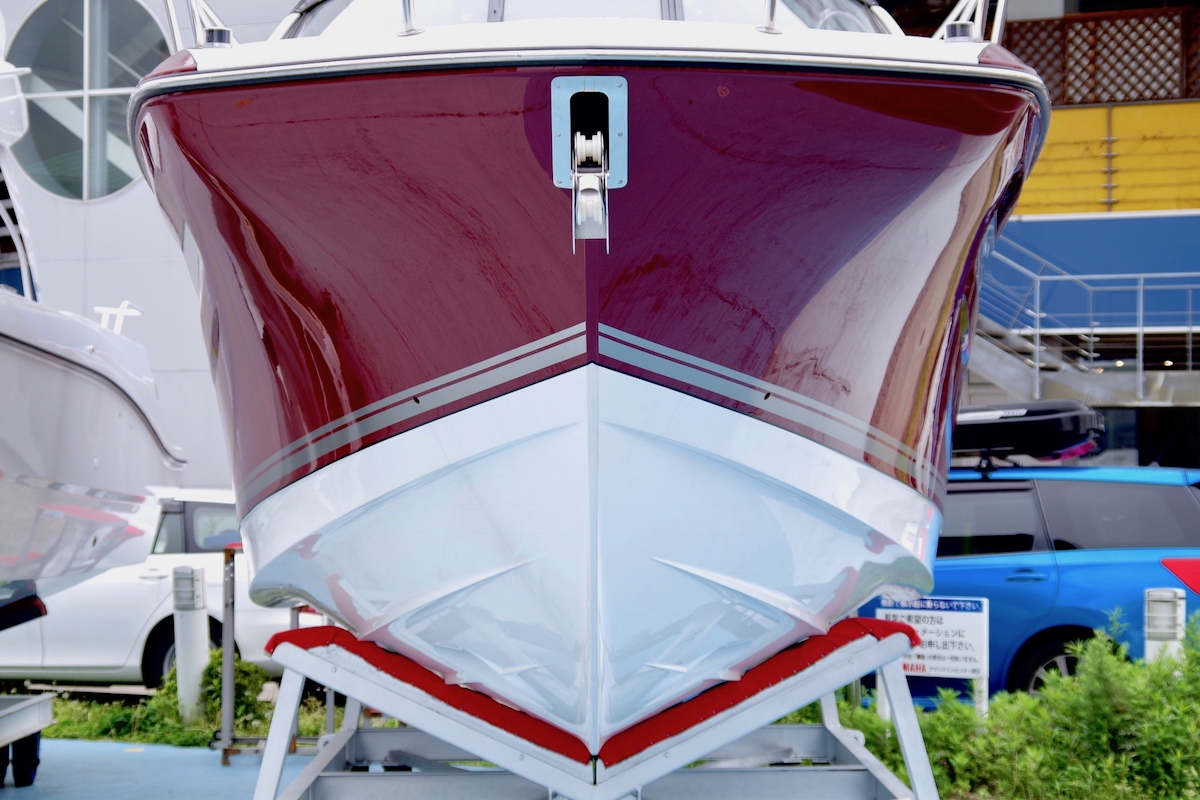
Learning how to paint a boat is easy, and if you want to make your boat look like new, you'll be surprised what a fresh layer of paint can do. Proper boat maintenance will go a long way in keeping your pride and joy looking great, but when that boat starts to appear aged, knowing how to paint a boat is the key to making it look like new again. And although painting a boat can be time-consuming and expensive, there’s no better way to improve an older boat’s appearance. While this is a rather complex process, we can boil it all down to these five basic steps.
How to Paint a Boat Step-by-Step:
- Remove all hardware (like rails, cleats, and vents) and/or any teak or wood trim on the boat.
- Repair any surface imperfections like chips, dings, or gouges.
- Prep the surface by washing, de-waxing, and thoroughly sanding it.
- Apply the primer, then the paint.
- Wax the boat from stem to stern to protect the new paint job.
Then, simply keep it clean, and rinse it thoroughly after use in saltwater. Remember, before you paint a boat always read the warning labels on all of the supplies and be sure to use the proper protective equipment.
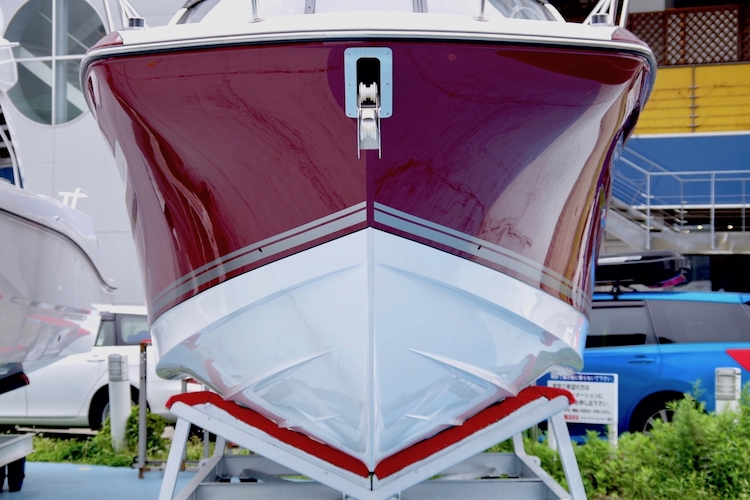
How to Paint a Fiberglass Boat
Painting fiberglass boats isn’t really much different from painting wood boats, except for the type of paint you’ll use and a few details in the prep and application. We should note that the very best finish can be attained by professionals who spray on the paint, rather than applying it with a brush and roller. However, anyone can do a bang-up job painting a boat if they make sure the surface has been properly prepped, and take care during the application.
Paints for Fiberglass Boats
- Single-Part Enamel Paints – These paints are easiest to apply and are less expensive than some other options. However, they also are subject to UV damage over time and the gloss doesn’t tend to hold up as well over the long haul especially if it isn’t constantly waxed and maintained.
- Single-Part Polyurethane Paints – Urethane paints are also easy to apply, don’t cost nearly as much as two-part polyurethanes, and have a long-lasting gloss.
- Two-Part Polyurethane Paints – These undisputedly look best and last longest. Many people would even argue they can out-shine a boat’s original gel coat. However, they are very expensive and are more labor-intensive, as they require mixing, an epoxy primer, and specific temperature and humidity levels for application.
Whichever of these you choose, job number-one is following the manufacturer’s instructions to a tee. We can’t lay out all the details here because each paint has its own specific requirements. The bottom line, however, is that each has its own instructions that can be quite exacting. And remember that like any paint job, good prep work is the key to success. De-waxing is one of the most important factors, because even a tiny amount of wax will prevent the paint from adhering to the fiberglass. Either acetone or a dedicated wax-stripper can be used but in either case, be sure to do a thorough job.
Tips for Painting a Fiberglass Boat
- Most people will use a standard “roll and tip” method for painting large surface areas of a boat. This requires two people and both rollers and brushes. As one person rolls out the paint, another follows behind with a brush and lightly strokes across the paint to brush out the roller pattern.
- One important tip for creating the best surface is to apply multiple, thin, consistent coats, as opposed to one or two thick ones. Three coats of paint is generally considered best.
- Another important tip to keep in mind: be sure to allow the proper amount of cure-time between coats (again following the manufacturer’s recommendations). And if the work takes place outdoors keep an eye on the weather to ensure the temperature and humidity will be acceptable and consistent throughout the entire timeframe.

How to Paint a Boat Bottom
Painting a boat bottom is a completely different experience than painting the boat’s upper hull and topsides. In this case you’ll want an anti-fouling paint that prevents marine growth, and there are countless versions to choose from. Read Antifouling Paints: Which Paint is Best For Your Boat to learn more about some of the different options.
Here’s the good news: learning how to paint a boat bottom is much easier than it is for the rest of the boat, because bottom paint tends to be simpler to apply.
- If the bottom is fresh gel coat, the same sort of prep work (de-waxing and sanding) is necessary.
- If you’re applying over old bottom paint, you can skip the de-waxing process and simply sand or power wash away any old or loose paint. Also, you won’t need to roll and tip; most people skip the tip part of this equation since the bottom will be underwater anyway, and simply roll the paint right on.
- There is, however, one additional factor to applying bottom paint to a boat: you may need to properly time the boat’s launch. Some paints have a minimum dry time but a maximum time as well, and will need to be launched within a certain window.
How to Paint a Boat Hull
Painting a boat’s hullsides is usually a lot easier than painting the topsides, simply because you’re dealing with a large, smooth surface area. There will only be minimal hardware to remove (in this case you may want to simply protect it with masking tape, though this rarely provides as good a final finish), and you won’t have to worry about angled surface areas or tight corners.
There is one variable to note, however, about painting a boat hull. You will be working on a more or less vertical surface, and if you apply the paint too thickly, drips and runs will result. So it’s very important to apply the pint evenly and thinly.
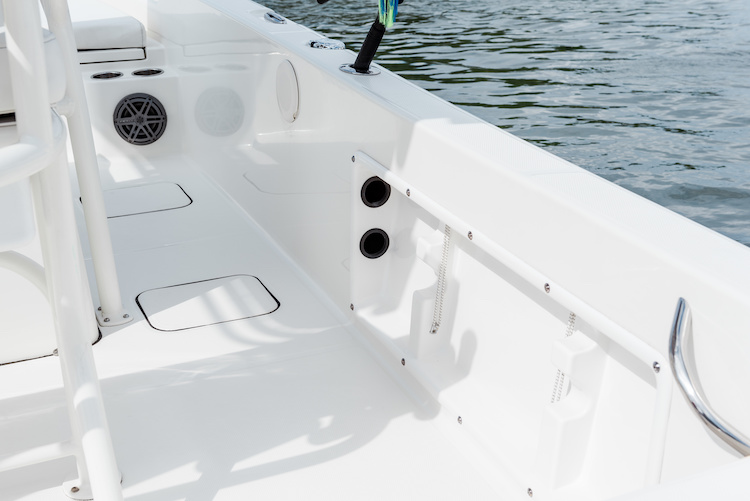
How to Paint a Boat with Non-Skid
Molded fiberglass non-skid and non-slip surfaces can’t be painted the same way as the rest of your boat. It’s impossible to sand or apply paint between the tiny imprints, and even if you did paint it, it would wear unevenly as people walk across the top of the pattern without ever touching between the raised surfaces. But that doesn’t mean you can’t make that old non-skid look like new again.
- The best way to paint non-skid is to apply a textured compound. There are several on the market designed specifically to paint a boat deck. They have some sort of grit or tiny rubberized pellets mixed in with the paint, to give the boat’s deck a fresh look but still maintain its non-slip properties.
- Once again, each has its own set of specific application instructions, prep work is key, and several coats are usually necessary.
- On additional variable you need to know about is the roller; since these paints have solids mixed in, you usually need to use a roller brush specifically designed to spread them.
Yes, painting a boat is a big, time-consuming job. Sure, it requires some expense. But remember, there’s no better way to make an older boat look new again than to give it a fresh paint job.
Editor's Note: Remember that many paints, primers, and wax strippers emit chemical fumes, and sanding can also create potentially harmful conditions for both you and the environment. Before you paint a boat always read the warning labels on all of the supplies and be sure to use the proper protective equipment.
Learn More in our Boat Maintenance Guide
Looking for more on boat maintenance and upkeep? Read...
- Antifouling Paints: Which Paint is Best for Your Boat?
- Boat Storage: What Are My Options?
- How to Winterize a Boat
- Spring Start-Up Checklist

Join Our Newsletter!
Get community news, buying bargains, and how-to guides at your fingertips.
You are using an outdated browser. Please upgrade your browser or activate Google Chrome Frame to improve your experience.
- Account details
No products in the cart.


Boat Owner’s Guide: How To Prepare and Paint a Boat
- Blog Boat Owner’s Guide: How To Prepare and Paint a Boat

Boats are exposed to a variety of elements and objects — water and all the vegetation and organisms that come with it, UV rays of the sun, extreme temperatures, sand, trailers, docks and more. It’s no surprise the paint on boats begins to crack and fade over time. When this happens, a fresh coat of paint can make a world of difference, but only if it’s done properly.
With the exposure to all these elements and objects, boats end up with peeling paint and dents. Simply painting over this uneven, damaged surface will leave you with an ugly paint job that is susceptible to peeling — and an expensive bill to fix it. They key to getting your boat like new is in the preparation. According to Sailing World, 75 percent of a successful paint job is the preparation . That means taking time to inspect your boat for problem areas, scrape off peeling paint, sanding, feathering, filling and priming — all before you apply your first coat of paint.
What you’ll need to get started:
- Protective glasses
- Tack cloth/rag
- Putty knife
- Dewaxing solvent
- Epoxy filler
- Random-orbital sander or finishing sander
- 80- to 120-grit sandpaper
- Paint roller
- Topside boat paint
- Boat bottom paint

How to Prepare a Boat’s Hull for Painting
If you’ve been wondering how to prepare a boat for painting, there’s no short answer. The reality is the actual painting of your boat takes the least amount of time — the preparation is the time-consuming part. However, with the right preparation, your coat of paint will last several years and make your boat look like new. So how do you paint a boat hull?
How to Choose an Environment to Prepare and Paint Your Boat
The preparation and painting of your boat begins with choosing a place to prep and paint. While the location may not seem like a big deal, this process is an investment of time and money, and the environment you choose can have a significant impact on the result. Here are a few of our recommendations for determining the perfect location.
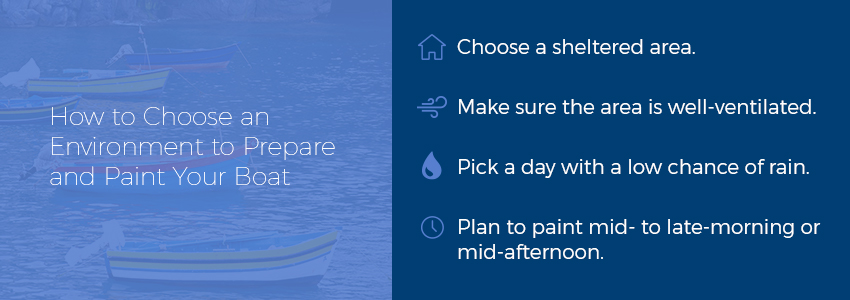
- Choose a sheltered area.
The ideal location for both preparing and painting your boat is under some sort of shelter. A shed is the best option, but you can also create your own shelter from tarps or plastic sheeting if a shed or other structure isn’t available. The ultimate goal is to have an area free of any windblown debris. Protection from the elements, including the sun, is another perk of prepping and painting your boat in a sheltered area.
- Make sure the area is well-ventilated.
The ideal location for both preparing and painting your boat is under some shelter. A shed is the best option, but you can also create your shelter from tarps or plastic sheeting if a shed or other structure isn’t available. The ultimate goal is to have an area free of any windblown debris. Protection from the elements, including the sun, is another perk of prepping and painting your boat in a sheltered area.
- Pick a day with a low chance of rain.
While protection from the elements and debris is ideal, it’s also important to balance that protection with ventilation. Even before you begin priming and painting your boat, you’ll be sanding and using solvents, both of which require a well-ventilated area to keep you safe from sawdust and fumes.
- Plan to paint mid- to late-morning or mid-afternoon.
Moisture isn’t just present on a rainy day, but also in the dew in mornings and evenings. Avoid painting first thing in the morning or last thing in the evening for these reasons. It’s also wise to avoid high noon, when the sun is at its peak for heat. Both of these extremes will impact paint drying time, so it’s best to plan accordingly and paint mid- to late-morning or in mid-afternoon — after the dew has evaporated. Save noontime for your lunch break.
How to Prepare a Boat for Painting

While getting a fresh coat of paint on your boat is the ultimate goal, the preparation is going to take the longest amount of time. If you skimp on the prep work, it will show in your paint job. Here’s how to do it right:
- Clean the boat.
The very first step is to thoroughly clean your boat. This is easiest to do shortly after you remove the boat from the water, when it’s still wet. To ensure you get a deep clean, you should use a combination of a pressure washer or high-pressure hose, scraper and rags.
Make sure you remove everything from the surface of your boat, including barnacles and other hard growth that may have attached to your boat. You want to start with a clean slate — anything like slime, dirt, sand or hard growth that is stuck on your boat will get in the way of a smooth paint job.
- Remove the hardware.
We know removing every single piece of hardware possible is time-consuming, but it’s the only way to ensure the best possible paint job. This includes any aluminum siding on your boat. If there are pieces of hardware you absolutely cannot remove, you can carefully cover them with painter’s tape.
If you’re wondering why you can’t just mask and paint around all the hardware, the answer is that the paint will often be on the piece of hardware and the boat. Over time, that paint will be much more likely to crack, welcoming in water and debris, which results in flaking and peeling paint and creates more work for you in the end. Do yourself a favor and dedicate the time to removing the hardware up front to avoid problems down the road.
- Strip the wax coating.
Almost all boats have a wax finish on them. Primer or paint won’t adhere to wax, so you must remove it before you apply to prevent headaches. If you aren’t sure whether or not your boat has a wax finish, usually simply running a finger along the surface of the boat will give you the answer.
Boat solvents, with the help of rough sponges, can help you get rid of any bit of wax that is on your boat. It may take a few rounds of scrubbing — you’re only finished when there’s absolutely no waxy feeling left on your boat.
- Tape off an area to paint.
Marking off the area you’re going to prime and paint is just as important as choosing the right kind of tape. If you pick the wrong tape, you’ll be spending a lot of time removing the tape and/or the residue it leaves behind. Invest in a “long-mask” tape, like 3M’s 2090 Scotch Blue Painter’s Tape, which can handle the UV rays, but also can be left on a surface for several days.
- Mark trouble spots with tape.
Once you have marked the area you’re going to paint first, it’s time to inspect that area for trouble spots. What exactly is a “trouble spot”? Look for dents, dings and places where the paint is chipped and/or peeling. Mark them all with a small piece of tape so when you’re finished, you can see all of the trouble areas that need to be addressed.
- Scrape off peeling paint.
Peeling paint isn’t going to help your new paint job. Air and water have already made their way between the paint and the surface of the boat, which means it will continue to peel even with a fresh coat of primer and paint on top of it. To ensure an even, well-adhered coat of fresh primer and paint, remove all peeling paint. If you’re applying a different type of paint than the old paint, you’ll need to scrape and sand off all the pre-existing paint.
The best way to do this is to scrape the paint off with a sharp putty knife, making sure you keep the edge of the knife parallel to the surface. Cutting into the surface will result in creating new dents, and ultimately, more work.
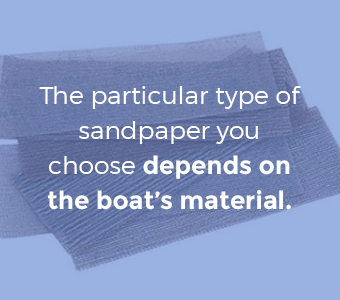
Once you’ve scraped off all of the peeling paint, it’s time to sand and feather the edges around those areas to get the surface as smooth as possible. Put on your mask and protective glasses to avoid inhaling toxic paint chips and sawdust. Use a random-orbit or finishing sander, like our Mirka Pneumatic Random Orbital Finishing Sander , but never a belt sander, which is sure to do more damage than good. You’ll want a rough sandpaper to get the job done — somewhere between 80- and 100-grit.Once you’ve scraped off all of the peeling paint, it’s time to sand and feather the edges around those areas to get the surface as smooth as possible. Put on your mask and protective glasses to avoid inhaling toxic paint chips and sawdust. Use a random-orbit or finishing sander, like our Mirka Pneumatic Random Orbital Finishing Sander , but never a belt sander, which is sure to do more damage than good. You’ll want a rough sandpaper to get the job done — somewhere between 80- and 100-grit.
The particular type of sandpaper you choose depends on the boat’s material. We recommend Mirka Abranet sandpaper , which relies on flexible fabrics with breathable, net-mesh designs. Breathable means this sheet provides dust-free sanding for materials ranging from aluminum to carbon steel. If you’re working with wood, Mirka Bulldog Gold Proflex Sandpaper has aluminum oxide grain, which gives you a good cut and excellent scratch pattern.
How to Prime a Boat
Once you’ve prepared the surface and have a clean, smooth surface free of peeling paint, you’re ready to prime the boat. While our directions are for two coats of primer, please note you may need to repeat filling and sanding a few times, depending on the number of dents and low spots you have.

- Wipe surface with a tack cloth.
Regardless of whether you use dust-free sandpaper and/or a vacuum to collect the dust, you still want to follow your sanding and feathering with a tack cloth. This cloth has just enough of a tacky finish on it to remove any remaining loose particles, leaving you with a flawless finish.
- Apply the first coat of primer.
Once you’ve wiped down the entire area with a tack cloth, it’s time to apply your first coat of primer. Resist the urge to apply a thick coat — instead, paint on just enough to cover the surface of the area you’re going to paint. Let the primer dry. Make sure you follow the manufacturer’s instructions for drying time and time between coats. Don’t panic if you can see uneven spots on the surface — we’ll address that in the next step.
- Fill low spots with epoxy.
Inevitably, you’ll notice uneven spots on the surface — maybe left over from dents or peeling paint you tried to sand out. Once the primer has dried, it’s time to touch up these low spots with epoxy. Using your putty knife, apply the epoxy and do your best to evenly spread it over the low areas, creating a surface that’s as even as possible. Then, let the epoxy cure.
- Lightly sand.
Once the epoxy has cured, you want to lightly sand the area with a higher-grit sandpaper, something close to 320-grit, to get a completely smooth surface. We recommend using Mirka Waterproof Sanding Sheets , specifically designed for wet sanding — just in case the epoxy isn’t 100 percent cured, this sandpaper will still get the job done without worrying about creating a mess.
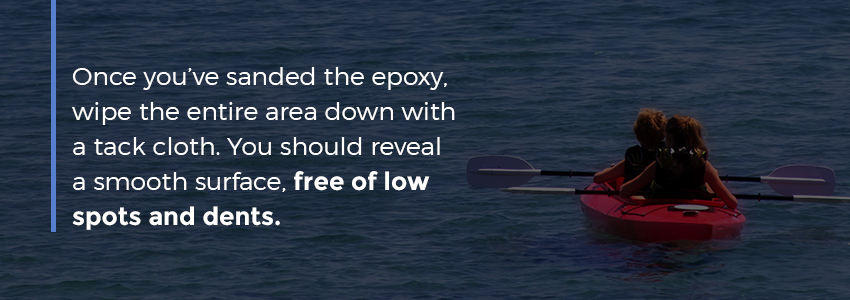
- Wipe with a tack cloth.
Once you’ve sanded the epoxy, wipe the entire area down with a tack cloth. You should reveal a smooth surface, free of low spots and dents. If you discover the area is completely smooth, move on to the next step. If you still see some low spots that could be improved, fill them with epoxy and repeat until you have a smooth surface.
- Apply a final coat of primer.
When you finally have a smooth surface, apply your final coat of primer and remove the tape while the primer is still wet. Let it dry — again, making sure you follow the manufacturer’s instructions for drying time and time between priming and painting. This final coat of primer should even out the color over the already seamless surface, proving your preparation is complete and you are finally ready to paint your boat.
How to Paint a Boat
The preparation is officially complete once the final coat of primer has dried. Now, it’s time for the final set of steps to complete your project — painting your boat.
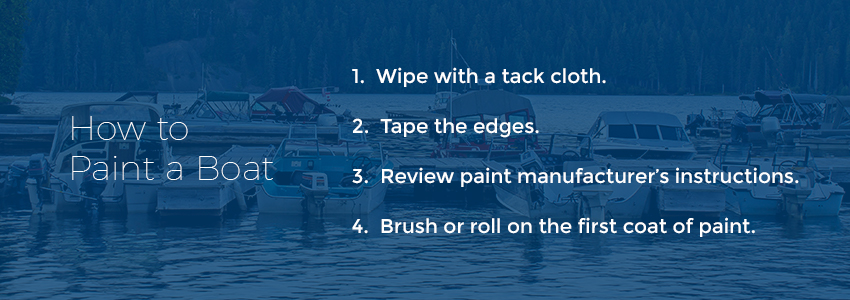
Once your primer has dried, wipe the entire surface down with a tack cloth, removing any loose dust or dirt that has accumulated.
- Tape the edges.
Once you’ve wiped down the entire area, tape the waterline and along the top edge of the topside. Again, be sure to use long-mask tape. In addition to taping the waterline, consider covering the boat bottom or antifouling area.
- Review paint manufacturer’s instructions.
Since there are different types of topside boat paints, it’s important to remember to consult the manufacturer’s instructions before you begin painting. Some paints require thinner or have other specific mixing instructions. You want to make sure you’re following every piece of advice the manufacturer gives you before you begin to apply the first coat of paint.
- Brush or roll on the first coat of paint.
Once you’re certain you have read the manufacturer’s instructions and have mixed the paint accordingly, it’s time to apply your first coat. The majority of topside paints can be rolled or brushed on, but again, the deciding factor should be whatever the manufacturer recommends. Begin by rolling or brushing perpendicular to the waterline, making sure to take shorter strokes and covering only a small area at a time. Then, brush or roll parallel to the waterline to finish. Let the paint dry and apply additional coats per the manufacturer’s instructions.
- Remove the tape.
Before the final coat of paint is dry, remove the tape. Waiting until the final coat is dry puts you at a higher risk of peeling paint along with the tape, causing you to have to start some of the preparing and painting processes all over again.
Painting the Deck and Bottom of the Boat
While there are a lot of similarities when it comes to preparing and painting the deck and bottom of your boat, there are also some notable differences.
The deck of your boat is likely a combination of fiberglass and non-skid surfaces. On the deck, it may not be possible to remove several pieces of hardware. In that case, you should meticulously tape off all the hardware and cover upholstery and electronics. Aside from that, the preparation and painting are very much the same, except for the non-skid surfaces. When these areas are damaged, you have two options — stick an entirely new non-skid surface over them, or paint them with a paint that contains a non-skid compound.

The bottom of your boat has maximum exposure to the water and all the growth and organisms living in it — so the paint selection for the bottom of your boat is different. What is bottom paint on a boat? Bottom paints contain a biocide, often in the form of copper, that is meant to continuously slowly fade away to expose more of the biocide, which prevents barnacles and other marine growth. For more information on bottom painting a boat, visit our how-to guide for painting the bottom of a boat.
Paint Your Boat Propellers and Running Gear
We’ve covered the topsides, deck and bottom of a boat, but should you paint your boat propellers and running gear? While the appearance of your propeller and running gear may not be a high priority, the performance is a top priority.
If you’ve been wondering how to keep marine growth from fouling your propellers, painting it just might be the answer. Applying a foul release coating to these areas can improve performance and protect your boat propellers by preventing the buildup of weeds, barnacles and more by creating a super-smooth hydrophobic surface marine life can’t latch onto.

By painting a foul release coating onto your propeller and running gear, you can expect to:
- Improve acceleration and maintenance of speed. The ultra-smooth surface creates less friction, which decreases drag and resistance, resulting in more knots.
- Decrease fuel consumption. Even the slightest buildup on your propeller and running gear causes more fuel to be used to compensate for the loss in speed and engine power.
- Reduce cavitation. An unhindered surface causes less disruption in the propulsion, and therefore causes fewer air bubbles.
- Eliminate the need for biocide and produce fewer CO2 emissions. Poisonous biocides aren’t necessary with this slippery surface, and the reduction in drag also means fewer CO2 emissions are produced.
Different Types of Topside Boat Paints
As a whole, topside paints are similar. Meant for use above the waterline, they’re durable, resistant to moisture, can endure hull expansion and contraction and resist UV rays. The differences between the types of topside boat paints are in how well they rank in each of these areas.
- Two-part polyurethane paints outperform every other topside paint when it comes to hardness, scratch and UV ray resistance and gloss and color retention. Why not stop here? Because it comes with a price tag to match. In addition to being the most expensive topside paint, it also requires very specific primer and application equipment.
- One-part polyurethane paints are perfect for do-it-yourselfers. While they don’t quite have the performance of two-part polyurethane, they’re easy to apply and provide a beautiful shiny gloss finish. They’re affordable, safer to mix and apply and easy to touch up.
- Alkyd marine enamel paints are very popular because they’re easy to apply, glossy and affordable. They require fewer coats, but will require a fresh coat each year, as they aren’t as durable. Their oil base makes them a great match for wood, and they’re easy to touch up.
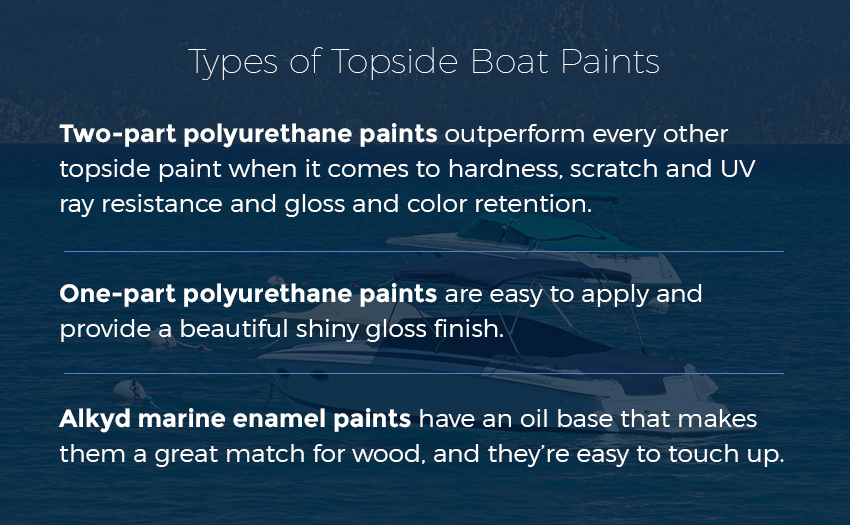
It’s important to remember that regardless of which type of topside boat paint you choose, you’ll need to check compatibility with the paint that’s currently on your topside. Two-part polyurethane paints, for example, can only be painted over other two-part paints. If you’re unsure what topside paint is currently on your boat, you can do a solvent test to check or strip the entire topside before painting.
National Abrasives, Inc.
At National Abrasives, we’re here to help you prepare your boat for painting, so it looks like new. Our random-orbital finishing sanders and Mirka specialty sandpapers will get every part of your boat ultra-smooth as you prepare to paint it. Take advantage of our bulk discounts free shipping and excellent customer service to make sure you always have what you need to prepare and paint your boat for the next season. Contact us to discuss your boat preparation needs, and we’ll recommend the products that will work best for you.
- PO Box 315, Lewisberry PA 17339
- 717.697.6776 | 800.459.8008
- [email protected]
VISIT OUR HEADQUARTERS
- 941 Mt Airy Rd, Lewisberry, PA 17339
- Open M-R 8am - 4PM Friday 8am-2pm
Shop Securely Online
- Request Credit Application

Ridetheducksofseattle is reader-supported. When you buy through our links, we may earn an affiliate commission. Learn more
How to Paint a Sailboat? Expert Tips and Techniques
Written by Anthony Roberts / Fact checked by Jonathan Larson

Some folks don’t like their sailing vessel’s color, so they may want to learn how to paint a sailboat DIY style. Or maybe the boat needs a retouch for a brand-new and more vibrant look while on the sea.
Regardless of the reason, this easy-to-follow sailboat painting guide will help you splash colors and breathe life into your sailing vessel. The steps are straightforward, although patience is essential.
Let’s start.
Table of Contents
Step 1. Clean and sand the sailboat.
Step 2. apply primer on the sailboat’s hull., step 3. get the paint ready., step 4. apply the paint., sailboat maintenance tips , ways to paint a sailboat.
Painting a sailboat is like coloring any object. It requires preparation, elbow grease, and commitment to complete the job.
Things you’ll need:
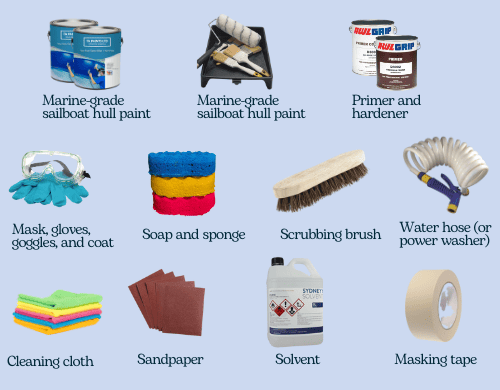
- Marine-grade sailboat hull paint
- Paint roller, brush, and paint tray
- Primer and hardener
- Mask, gloves, goggles, and coat
- Soap and sponge
- Scrubbing brush
- Water hose (or power washer)
- Cleaning cloth
- Masking tape
We understand painting a sailboat can be intimidating for beginners. It can be a fun experience (though tiring), too. So, we prepared a four-step process to make this activity as easy to follow as possible.

Surface preparation is crucial in any paint job. You’ll want a clean, contaminant-free, and smooth surface to ensure the paint adheres to the hull. Here’s how to get your sailboat ready for a paint job.
- Wear your protective gear.
- Check for any signs of damage and repair them accordingly.
- Spray your sailboat clean using a power washer or a hose until the hull is free of dirt, grease, barnacles, etc.
When encountering stubborn objects, scrape them off with a scrubbing brush.
- Create a soapy solution and moisten the sponge. Scrub the boat with the cleaning agent to remove stains.
- Rinse thoroughly.
- Once dry, roughen the boat with 80- to 100-grit sandpaper. Finish the job with 220-grit sandpaper to smoothen the surface.
Pro Tip: Use an orbital sander with a 40- to 80-grit sanding disc for better results.
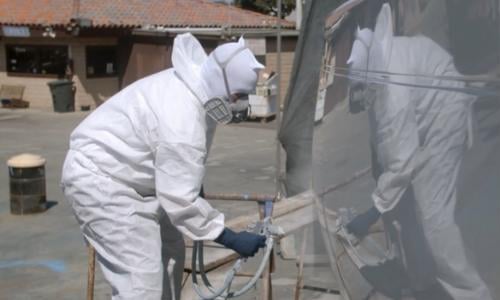
A paint primer is crucial for any painting project, whether by hand or machine. This initial coat gives the boat paint something to “cling” to, ensuring it lasts longer than a primer-less surface.
- Remove all the hardware from the vessel.
- Cover sailboat trims and other elements you wish to leave unpainted. The tape’s straight edge also guarantees more uniform coats.
- Combine the epoxy polymer and hardener following the brand’s instructions.
- Pour the mixture into the paint tray and run the roller to coat it with the priming solution.
- Apply the primer on the sailboat’s hull, covering every square inch.
- Leave the primer to dry for about a day.
- Repeat the primer application three more times, allowing each coat to dry for a day before applying the next layer.
- Lightly sand the primed surface with 300- to 400-grit sandpaper until the boat is smooth.
- Dip a clean rag into a solvent, such as mineral spirits and xylene, and wipe the boat again.
Pro Tip: Use a small paintbrush to apply primer on corners and other areas the paint roller cannot reach.
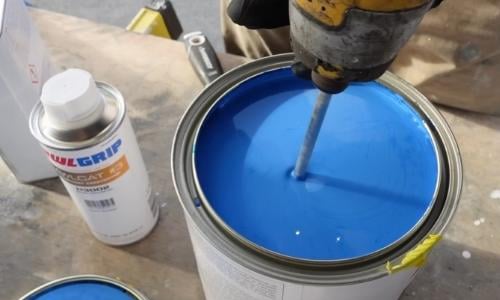
You can either retouch your boat with acrylic paint or a marine-grade variant.
- Acrylic is water-based. Therefore, applying it on a boat might not provide adequate waterproofing, which can result in premature peeling.
However, acrylic paint has the advantage of drying quickly and containing less toxins. To mitigate its drawbacks, you can apply a waterproof coating as the final layer.
- Marine-grade paint is usually the preferred choice, as it’s waterproof, UV-resistant, and salt-resistant.
That said, marine-grade paint is not for easy sailboat painting since it’s a lot harder to apply and requires meticulous handling. In addition, it’s also pricier than acrylic paint.
In either case, please follow the paint manufacturer’s instructions on preparing and mixing the pigment.
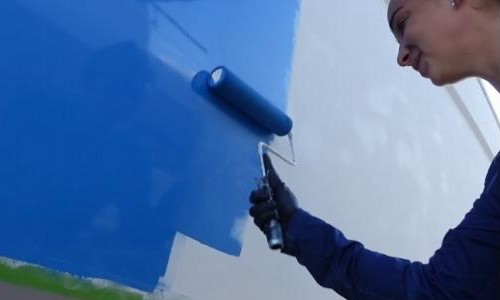
You’re ready to apply paint colors to your sailboat. This step might vary a bit depending on the paint manufacturer. Hence, we highly recommend reading the painting instructions.
- Hose down the area you’re working to settle the dust.
- Pour the boat paint into the tray and lightly dampen the roller with water.
- Immerse half the roller into the paint can and run it several times on the tray for even distribution.
- Paint the sailboat’s hull, ensuring firm and even pressure. Maintain uniform strokes.
- Dip the paintbrush into the paint and remove excess pigment. Paint areas the roller cannot reach.
- Leave the paint to dry following the manufacturer’s recommended curing time.
- Smoothen the surface with 400-grit sandpaper (you can use finer-grit sandpaper). However, you might want to check the paint manufacturer’s guidelines if this step is necessary.
- Apply a second and third paint coating, ensuring the recommended drying time between applications.
Pro Tip: Apply two layers of top coat and antifouling paint to make your DIY sailboat paint job last longer.
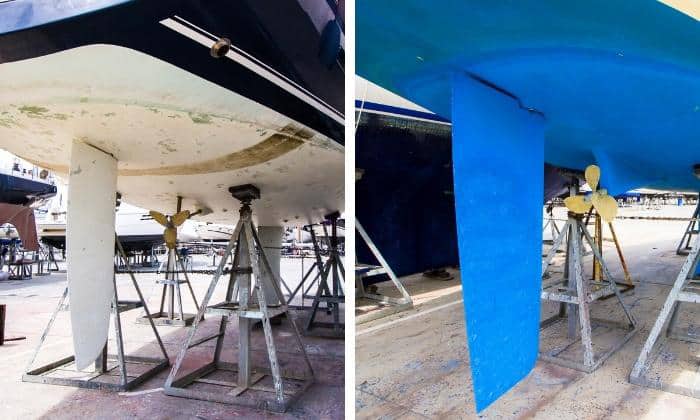
Maintaining a sailboat is crucial because it prolongs its lifespan and boosts its resale value. After all, nobody would want to buy a barnacle-ridden, stain-filled watercraft.
- Wash and clean your sailboat periodically with mild, boat paint-friendly cleaners to avoid removing the paint’s protective coating.
- Use soft water when cleaning the sailboat because hard water can strip pigments off the hull.
- Apply a marine-grade UV protectant or sealer after every wash to leave the sailboat looking pristine and brand-new.
- Repaint a boat with marine-grade pigments at least once annually, especially if you don’t take it out of the water and notice telltale signs of damage or deterioration.
- Choose a sailboat paint to meet your needs. For example, gelcoat paints are ideal for creating a mirror-like finish but require frequent reapplication. Meanwhile, polyester-based topcoat paints can produce gelcoat-like finish but last longer.
Learning how to paint a sailboat offers many benefits beyond extending your watercraft’s lifespan, allowing you to enjoy more leisurely cruises with your loved ones. Painting a boat can be relaxing and rewarding, too. It unleashes creativity and empowers you to be more productive.
However, painting a sailboat takes time, although the process is easy. And if you are a busy bee, you’re better off handing this task to the pros. The results might even be better, except nothing can bring more joy than a project you complete with your hands.

I am passionate about water sports and technical fields, so combining both makes me interested in making contents about boat accessories. With my partner, we went on many trips and sports games together, which led us to think about how we can spread our joys and passions to many people.

A Trusted Source For Boating Information Since 2019
Should you paint or re-gelcoat a boat hull.
- Post Written By: Boater Jer
- Published: May 2, 2021
- Updated: July 8, 2022

Disclaimer: You might notice that we recommend products in some articles. We may earn a commission for referring you if you click the link and buy a product.
We only recommend products we’ve tried/tested/own (that’s why you won’t find thousands of affiliate links on my site). If you have experience with one of the products we’ve mentioned, please share your experiences in the comments at the end.
Advertisement

A regularly waxed gelcoat can last for up to 15 years on the boat. This figure can vary based on how well you take care of your boat’s hull. If you’re having trouble deciding whether to re-gelcoat or paint the hull, here’s a fantastic guide for you (and your boat).
It is safe to paint the hull if the gelcoat is in good condition. A good condition gelcoat is one, which still retains gloss and does not show white chalky powder on the surface. If the gelcoat lacks these signs, then re-gelcoat the boat’s bottom, or else I recommend painting at least.
This article talks about whether you should paint or re-gelcoat your hull. We will also cover the steps to re-gelcoat and paint the hull. So keep reading this article until the end for more information!
Re-gelcoat The Hull
Let’s see when you should re-gelcoat the hull along with the quick steps for the same, before getting started, inspect the gelcoat.
If it’s still in good condition, it shows no sign of wear, tear, damage, cracks, etc., there is no need to re-gelcoat. In such a case, follow the steps below to get the job done at the earliest.

- Clean the gelcoat surface.
- Apply an epoxy primer on the surface.
- Sand the primer until you think it’s sufficient.
- Clean the sanding residue and finally apply the topcoat. You can also paint the surface if you feel so.
If there is a crack(s) (no matter the size) or the gel coat’s surface is somewhat chalky, then you MUST do the repairs. For this, follow these quick steps:
- Clean the gelcoat to prepare the surface. Make sure that there are no residues of oil, wax, dirt, etc.
- Now scrub the surface with the soap water, and don’t forget to rinse the soap residue. If the water does not separate while flowing down the surface, that means you’ve cleaned the surface correctly.
- Carefully inspect the surface for any damages such as cracks, dents, etc. Fix the issues on the surface (if any) before proceeding any further.
- Now it’s time for sanding. You may use 320 to 400-grit sandpaper. Unfortunately, the sanding will leave some residue again, so wipe them off to get a clean, beautiful surface.
- Apply the gelcoat. 2-3 layers might be sufficient.
Painting The Hull

If you don’t want to gelcoat the bottom of the boat, you may paint it alternatively. Leaving the hull’s surface unprotected will let organisms spread all over the surface, which will hinder the boat’s speed, handling, and overall performance. Furthermore, it can cause minor to severe damages to the surface over time, which is troublesome in the long run.
The painting will, without a doubt, increase the lifespan of the boat drastically. If your boat stays in the water for a long time, painting the hull is strongly recommended.
Gelcoat Vs. Paint- A Strong Debate
In some cases, gelcoat proves to be better than paint and vice versa. We will now take a look at a few points in the form of an interesting debate.
Gelcoat can effectively protect your boat’s bottom against UV and harmful chemical reactions that might take place on its surface. Since the bottom part of the boat is exposed to several kinds of chemical reactions taking place in the water, the gelcoat layer will give you a huge advantage. On the other hand, paint is practical and offers protection against such issues, but to a minimal extent, comparatively.
Repairing Cost And Other Requirements
Gelcoat application can be expensive as compared to paint. But the longevity of the gelcoat still makes it cheaper than paint and worth every penny. Please remember that gelcoat will be expensive only if you’re re-coating the surface from scratch. Minor repair/patchworks, on the other hand, will be cheap. Furthermore, gelcoat application can be tiring, requiring a lot of patience, skills, and of course, all the materials to prep and apply.
Paint, on the other hand, does not demand as much time, skills, or money. So if you can’t invest much time, we recommend you to go for the paint. Furthermore, if you’re impatient and lack the required skills to gelcoat the surface, then painting the bottom of the boat is the best way to stay on the safe side rather than messing up everything.

The major disadvantage of the paint here is that you will have to repaint the surface every year. Although paint can last for about 8 to 10 years, for the sake of the boat’s longevity, paint it once every year or two. The painted surface can fade sooner than expected, even though it can still offer protection at the same time. Gelcoat, on the other hand, will retain its shine for years.
Self-Leveling
Unfortunately, gelcoat IS NOT self-leveling. If you’re working with the gelcoat for the first time, or if you’re still a newbie, there is a reasonably high chance that you will fail to level the gelcoat properly. To overcome this issue, you can use sandpaper to level up the gelcoat. Paint, on the other hand, does not need to be leveled up. No hassle, quick and straightforward!
Comparison Table For Gelcoat And Paint
You might want to take a look at the comparison between gelcoat and paint to get a better idea of whether to re-gelcoat or paint the boat’s bottom.
The Last Few Knots
We will now try to settle the debate on gelcoat or paint. Remember that it’s the hull we’re talking about here. Since the hull will be in contact with water the entire time, extra safety measures are essential. Therefore, gelcoat is a better option. But when do you need to do it?
When To Re-Gelcoat The Hull?
Here are a few conditions and situations in which you should opt for the reapplication of gelcoat instead of painting your boat’s bottom.
- If you can afford to re-gelcoat the entire hull from scratch, then go for it. Remember that in addition to the gel coat’s cost, you will also have to spend on repair work (if any) on the hull’s surface.
- Re-gelcoat in the case where you have enough skills, time, and patience. Since this work requires heavy labor, go for it only if you can do so. Hiring someone to get the work done will further increase the total cost of repair work.
- To re-gelcoat, you will need a well ventilated open space and do the repairs on a clear day. If you lack these things, then maybe you should drop the idea to re-gelcoat the boat.
- If you leave the boat in the water for a long time (or maybe regularly), then we strongly recommend that you re-gelcoat the hull. Paint won’t be as useful in this case.
- Re-gelcoat your boat’s bottom if the old gelcoat is all worn out, and there’s no way to revive it.
When to Paint The Hull?
The following situations favor painting your boat’s bottom instead of reapplication of gelcoat.
- If you’re low on budget and can’t afford to spend on the gelcoat and then on repairs, then paint the boat. But remember that you’ll need to repeat the process in a year or two.
- Opt for paint if you don’t want to spend the whole day repairing the boat. Paint the bottom of the boat and let it dry.
- Painting does not need as well-ventilated or open space as a gel coating might require. Just try to avoid doing it on a rainy day, as the air will be full of moisture from high humidity.
- If you will take your boat in water occasionally or rarely, then painting is recommended.
- You can paint the boat’s bottom over the old gelcoat if the gelcoat is in good condition. It will give an added layer of protection to your hull and revive shine for a while.
- If you’re not getting your desired color options in the gelcoat, then you can paint your favorite color on the bottom of the boat.
We have covered all the points necessary to help you decide whether to re-gelcoat or paint the boat. It’s totally up to you what to choose, and now that you’ve learned enough, it’s time for you to act. Good Luck!

- https://www.sailmagazine.com/diy/how-to-prepare-your-boat-for-painting-a-gelcoat
- https://www.boatdesign.net/threads/wanting-to-apply-new-gel-coat-over-old-gel-coat.51852/
- https://findanyanswer.com/how-much-does-it-cost-to-get-a-boat-gel-coat
- https://www.myyachtmanagement.com/news/2018/gelcoat-finish-vs-marine-paint-for-your-yachts-hull#:~:text=Painted%20hulls%20are%20especially%20resistant,less%20durable%20than%20gelcoat%20finish.&text=It%20dries%20to%20a%20glossy,additional%20clear%20glossy%20top%20coat .
- https://www.thehulltruth.com/boating-forum/251438-gel-coat-vs-paint.html

Crab Island by Pontoon: A Fun Watery Boating Guide Destination in 2024

Upgrade Your Boating Experience: Adding a Third Pontoon Made Easy!

How Long Does It Take A Canoe To Go… (Canoe Calculator Here)

In-Depth Review of the Pelican Sentinel 100X Fishing Kayak: Pros, Cons, and Performance

How To Put A Kayak In The Water – The Ultimate Guide For New Kayakers

Best Cruising Catamarans For Couples
- PowerDolphin Wizard Water Surface Drone – Best Surface Drone?
- Aluminum vs. Fiberglass Bass Boats
- Sailor’s Superstition: Why Are Green Boats Unlucky?
- How To Make A V-hull Boat More Stable – Increasing Watercraft Stability
fakerolex.to

Share this post with your friends
Subscribe to our newsletter.
Join us in our love for all things water. And Adventure.

Do Catamarans Make You Seasick?
Advertisement Seasickness resembles motion sickness occurring while on a boat. The level of uneasiness can vary based on the vessel. Seasickness varies based on the sailing comfort. Smoother the ride, fewer chances of seasickness. But, catamarans are well-known for smoother rides. So will it make you seasick? Let’s find out. Catamarans can lower the risk

A Wizard of Technology – The PowerEgg X Wizard Waterproof Drone
The PowerVision PowerEgg X Wizard Drone – A Waterproof, water-landing aerial drone of the future, today. This thing is just plain awesome.

PowerRay Wizard Underwater Drone – Nothing Short of Awesome.
The PowerRay Wizard Underwater Drone is a feat of technology at a budget price. It’s no wonder this thing won so many awards. Find out how to get yours with extras.

The Geneinno T1 – A Professional Diving Drone With Robotic Arm
Advertisement What’s so great about an underwater drone? Small drone aircraft systems are a ubiquitous sight these days. It is most unlikely that you haven’t spotted one in real life till now. But underwater drones are not something of an everyday view. Submarine ROVs or UAVs are making huge waves now (notice the pun?). No

A Boaters Guide to Suzuki Outboard Engines
Advertisement Till 1994, Suzuki manufactured two-stroke outboard engines. But to grow in the boat market, it began manufacturing four-stroke outboard motors, whose popularity was a big hit. Still, many people wonder if Suzuki makes good outboard motor? People may doubt the quality of Suzuki’s outboard engines. However, with proper maintenance, the motors can last for

Can A Catamaran Capsize?
Can a catamaran capsize? Can it sink? Is it safe? I take a deep dive into the subject to bring you the straight answers. No pun intended.

Boat Information By Type
© 2023 Boating.Guide, A Hyperwave Media Group Ltd. Publication.
Privacy Overview

How to Paint Your Boat: A Step-by-Step Guide to Paint a Boat
Ahmed m. aly.
- June 27, 2023

Boating is a good leisure hobby that allows you to be amidst nature. You can use your boating time to enjoy the beauty of nature and engage in various activities like fishing and meditation. Whether you own a simple bass boat or a larger vessel with a superstructure, one thing remains common; your boat will eventually lose its shine and require a fresh coat of paint. This is where knowing how to paint your boat becomes essential.
In this article, we’ll discuss the different aspects of painting a boat. We’ll cover the advantages of taking on the project yourself, the various types of paints suitable for boat painting, and a step-by-step process to assist you in achieving a professional-looking finish with regular maintenance. Let’s get started!
Is Painting Your Boat Worth it?
Many of you might have painted a door or a portion of the wall of your home. But is it possible to entirely paint your boat on a DIY basis? Well, you must first understand that boat painting is more complex than a door or wall.
Secondly, the work involved depends on the size and complexity of the boat. It requires many working hours, material, and patience. If you are inclined to invest your time and have the patience to learn and do it, then you can successfully attempt it.
You have to do the boat painting at regular intervals. If you leave the boat without maintenance for a very long period, only a professional can bring it back to its original shine, which can be costly.

The Three Parts of a Boat Paint Job
- The first part is removing all the possible hardware and protecting the remaining hardware with painter’s tape.
- The second part is preparing the surfaces for painting, which involves getting rid of the existing coating of the paint and creating a profile or texture required for good adherence.
- The third part is applying the recommended primer and paint.
The second part is the most challenging and laborious, and you have to understand the work involved before deciding whether to do the boat painting on a DIY basis and whether it is worth it.
However, there is one solution. You can offload the surface preparation job to a wet abrasive blasting expert and do the remaining work yourself (parts one and three). Wet abrasive blasting is an effective, fast, and environmentally friendly solution for preparing the boat surfaces for painting.
The wet abrasive blasting can create the required texture or profile on the surfaces for good adherence to painting. Wet abrasive blasting is possible on wood, aluminum, and fiberglass. The advantage is it can reach and remove the old paint from all the nooks and corners of the intricate inner boat surfaces. You can enquire with your local contractor; they usually have portable wet abrasive blasting units.
Types of Coats / Paints Available to Paint Your Boat
The paints used for boat painting are called marine paint, and they are manufactured suitable for the marine environment and to protect your boats from salt water and lake water.
Marine paints give corrosion and abrasion resistance to the painted surfaces and maintain hydrodynamic properties. Some marine paints also have anti-fouling and self-cleaning properties.
Different paints are available in the market, like simple enamel paints, single and two-step polyurethane, etc. Polyurethane paints last longer than enamel paints. Ensure the selected primer and paint are compatible.
Paints for the Topsides of the Boat
The topside includes surfaces above the waterline, such as, hull, deck, and the inside from the gunwale. Marine paints used for boat top painting should resist UV (Ultraviolet) rays since they are exposed to the sun and susceptible to UV damage.
Paints for Bottom Side of the Boat
This refers to the portion below the waterline. Marine paints used for boat bottom painting should resist aquatic and marine growth.
Types of Paints Suitable for Different Boat Types
Your boat may be of wood, aluminum, or fiberglass. Let us briefly discuss the paints suitable for painting these boats.

Aluminum Boats
Marine grade aluminum paint for boats can be used for touching up or restoration. The advantage of aluminum paint is it dries fast, and some aluminum paints do not need a primer.
Aluminum paint can be used on all the areas of the boat (boat bottom painting and top painting). Read the manufacturer’s directions for applying this paint.
Wooden Boats
If you have a wooden boat, it is better to stick to the traditional oil-based paints recommended for marine applications.
Spending money on expensive two-part paint may not be worth it since a wooden boat swells and flexes typically along the seams, and the paint, whether oil-based or two-part, has the same life. Make sure to read the manufacturer’s directions for applying the paint.
Fiberglass Boats
Fiberglass boats can be painted with enamel paint, one or two-part polyurethane paints, gel coat, etc. This can be “rolled and tipped” or sprayed onto the boat’s fiberglass surface.
Ensure the paint is recommended for marine use and read the manufacturer’s directions for applying the paint. Some manufacturers offer acrylic latex paint for painting fiberglass boats.
One-part Enamel Paints
These paints do not involve mixing different ingredients; they are economical and easier to use than high-end paints. Conversely, they are susceptible to UV damage over time and need additional caution, like periodic cleaning and waxing.
Polyurethane Paints
These can be one part or two parts. Polyurethane is the most prevalent form of one-part paint because its long-lasting gloss is less expensive than two-part polyurethane paint, and it has a better and long-lasting gloss finish than enamel paints.
Two-part polyurethane paints cost more than the other paints discussed above, but they look better and last longer.
Apart from the high cost, a two-part polyurethane paint needs additional labor (for mixing) and an epoxy primer, and the painting has to be done at the recommended ambient temperature and humidity.
Interesting Read: Different Types of Boats | Your Guide to Boat Types
Step-by-Step Process of Painting Your Boat

Your boat may be of wood, fiberglass, or aluminum, but the method and steps of painting will be more or less the same.
Professionals use spray painting techniques to get a good quality painting. If you have the facility, you can do spray painting. However, you can achieve a fairly good painted surface using a roller and brush, provided the surface preparation is good.
Normally, a team of two persons does the boat painting, the first person does the painting using a roller, and the second person follows the first with a painting brush and evenly removes the roller pattern using light strokes.
Steps to Paint Your Boat
Step 1. wash the boat.
Wash the complete boat with soap water followed by clean water to remove all the dirt, marine growth, sand, etc. You can use high-pressure water if available.
Step 2. Collect the Paining Materials
Collect all the painting materials, such as, primer, paint, sander with discs, emery paper, rollers and brushes for painting, safety gear, etc. If you have yet to learn how to use a sander, take the help of a professional and learn how to use it.
Read all the instructions on the primer containers, and paint and follow the safety guidelines like wearing a respirator, safety glasses, and recommended clothes during sanding and painting.
Step 3. Repair Leakage Points
Inspect all the areas of the boat, including the superstructure and make a list of leakage points (the leakage may be through a fastener, fitting, damaged joints, corroded parts, etc.) and attend to them before boat painting.
Mark the chipped and cracked areas and rectify them. You can use the services of your experienced friend or a professional to help you.
Step 4. Protect Boat’s Hardware
Take out as much of the hardware items (bow rails, cleats, fasteners, beadings, etc.) from the boat, and the remaining are to be protected using painter’s tape. All the corroded fittings and fasteners are to be replaced.
Do not think stainless steel is rust-proof; it has higher corrosion resistance, but seawater can corrode it over time. All the rubber beadings are to be replaced.
Step 5. Surface Preparation
The next step is surface preparation. You have to get rid of the old paint and prepare the surface for the new paint, this process is called surface preparation or prep work.
Use the painter’s tape to cover the areas that are to be protected and to mark boundaries. Use a sander with 80,120, 220, and 320 grit sandpaper to remove the paint and the glassy surface and create an even and smooth surface profile/texture.
The surface preparation includes intricate inside parts, like decks, cabins, cockpits, fly-bridges, and other parts. This is a complex process and takes your time and needs patience.
Step 6. Remove Protection Tapes
Remove the tape. Wash the sanded surfaces with pressure water and a sponge and allow them to dry.
Step 7. Clean the Surface
Clean the surface using a quick evaporating cleaner and a clean microfiber cloth.
Step 8. Preparations for Painting
Cover the areas and parts of the boat that are not to be painted (with painter’s tape).
Step 9. Apply Primer Coat
Pour sufficient primer into the painting pan for one or two-hour paintings (depending on your capacity). Dip a roller into the primer to start painting, and you can make horizontal or vertical strokes with the roller. After painting about three feet, take a brush and remove the roller lines to make the painting even and smooth.
This method is called the roll and tip method. Use the roller again to paint the next 3 feet, and use the brush to smoothen. Ensure the painting looks even, continuous, and smooth. Continue this process till you cover all the surfaces (you can take the help of your friend for brushwork).
Allow the primer to dry overnight. Use the sander with 320 grit sandpaper to remove the glassy finish, and do not sand off the primer layer. Do another coat of primer and repeat the process.
Sanding with 320 or higher grit sandpaper between coats of primer and paint help remove paint bubbles, spots, etc.
Step 10. Post Primer Cleaning
Use a microfiber cloth and fast-evaporating solvent to clean the surface.
Step 11. Apply Remaining Coats
If necessary, remove the selected paint, mix the constituents, and pour the paint into the pan. As discussed above, use a roller and paintbrush to paint the surface.
Ensure the coating thickness is thin. Allow the paint to dry overnight. Sand the painted surface with 400 or higher grit to remove the glassy finish. Continue the above painting process to do the second and third coats of paint.
Step 12. Final Finishing
Use the wet sanding process with higher grit sandpaper (800 or 1000) to make the painted surface slightly dull (this will remove any visible brush lines), and then do the buffing with a buffing wheel and 1000 and 2000 grit buffing compound.
You can also wax the painted surfaces to make them shine.
The above process can be used for the top portion of boat painting, but it also applies to painting other parts of the boat. Let us discuss a few points about painting the boat hull, the inner surfaces, the boat bottom painting, and painting bass boats.
How to Paint Your Boat’s Hull?
The hull is a large and smooth surface area without much hardware to remove. You may want to protect it with masking tape . Y ou will find it easier to paint a hull than the top sides of a boat. There are no angled surfaces or tight corners.
The boat’s hull is a near-vertical surface, and multiple thin coats are preferred for painting it since the paint from a thick coat of paint can drip and spoil the painting.
If the gelcoat on the hull is severely oxidized and has a chalky look, the oxidized outer layer will have to be removed. When done sanding, run your hand along the hull and feel for dips and grooves. You can even stretch a thin batten along the hull to double-check the smoothness of the hull.
Repair any surface imperfections like chips, dings, or gouges . Once you’ve filled all the dips and dents, allow the filler to dry.
Painting the Inner Non-Skid Surfaces of a Boat
Painting the inner non-skid or nonslip surfaces differs from painting the outer surfaces since sanding all the tiny nooks and corners of the inner boat may not be possible.
The inner boat surface may have raised patterns with space in between. Also, the wear on the inner parts of the boat will be uneven since people walk on the top of a pattern, and the space between the two patterns is left untouched.
You can select a textured compound for nonslip and non-skid painting that have minute rubberized pellets mixed in the paint.
This paint looks good and also gives an anti-slip surface. Also, you must select a special painting roller since this paint has solid particles.
How to Paint Your Boat’s Bottom?

Unlike the top of your boat, the bottom is susceptible to the growth of barnacles and other marine organisms. This means you’ll need to use anti-fouling paint when repainting a boat to keep them at bay.
You have a wide variety to choose from but choose the one that is environmentally friendly and does not harm marine life. You will find bottom boat painting is more straightforward than painting the hull and other parts.
Painting a Bass Boat
Bass fishing is a leisure activity in parts of North America to catch bass species fishes using a fishing rod, and the boat used for bass fishing is called a bass boat.
A bass boat is a small boat designed and equipped mainly for bass fishing in lakes, rivers, and wetlands. Modern bass boats are propelled by a motor equipped with an elevated front deck and a swivel chair for convenient movement around the boat during bass fishing.
Bass boats may be made of aluminum alloy or fiberglass. The small size of a bass boat allows you to propel it with oars in times of emergency.
The small size of a bass boat makes it convenient for DIY painting, and you can paint a bass boat by following the same step-by-step process discussed above.
Tips for Boat Painting and Boat Maintenance
- Paint your boat on a dry, cool day or under the shade. There should not be high temperatures and high humidity.
- One important tip for creating the best surface is to apply multiple, thin, consistent coats instead of one or two thick ones. Three coats of paint are generally considered the best.
- Follow the paint manufacturer’s instructions, allow sufficient curing time between coats, and keep an eye on ambient temperature and humidity, especially if you are painting in the open. Ensure that the temperature is between 55 and 75 F and humidity is below 80 percent to provide optimal curing.
- Adhere to the drying time specified by the paint manufacturer before taking the repainted boat into the water.
- Avoid breathing in sanding dust and paint, and solvent fumes.
- Make it a habit to rinse the boat after use in saltwater.
Preserving the longevity of your boat requires diligent maintenance, including regular painting. Whether you own a small bass boat or a larger one, investing time and effort into learning how to paint your boat will undoubtedly pay off in the long run.
By understanding the different types of paints suitable for boats and following a step-by-step guide, boat owners can achieve a professional-looking finish through regular maintenance.
So, take the reins and breathe new life into your boat with a fresh coat of paint that can enhance its appearance and longevity.
References:
- BoatworksToday YouTube Channel.
- PowerBoat Television YouTube Channel.
Boat Collisions: How to Avoid Collisions with Another Boat
Boating can be a fun and relaxing activity that many individuals enjoy. Whether cruising along the coastline, fishing with friends,

What is a Jet Boat? Propulsion System, Types, Pros and Cons
Jet boats are thrilling, high-speed watercraft making waves in the boating industry. Unlike conventional boats, a jet boat uses powerful

How to Steer a Boat: Mastering the Art of Boat Steering
If you’re ready to embark on a boating adventure and take hold of the helm, it’s time to dive into
Workshop Insider Newsletter
Be a workshop insider get our latest collection of news and announcements delivered to your inbox..., latest articles.
- September 12, 2023
The Ultimate Guide to Pipeliner Welding Hoods: Features, Benefits, Buying Guide, and Best Practices
- Welding Helmets Buying Guides
- September 11, 2023
- September 10, 2023
J-B Weld Removal: How to Remove JB Weld from Metal, Plastic, Skin, and More!
- Mechanical Engineering , Welding Technology
- August 19, 2023
- August 17, 2023
What are Bellows on a Boat: Everything You Need to Know
- August 16, 2023

- Privacy Policy
- Terms of Use
- Affiliate Disclosure
RetireFearless
Cost To Paint The Hull Of A Sailboat
Are you looking to repaint your sailboat’s hull? Many factors impact the cost of hull painting. So, how much does it cost to paint the hull of a sailboat?

March 16, 2023
This article may contain affiliate links where we earn a commission from qualifying purchases.
Whether you’re a first-time boat owner or you’ve been sailing for years, one of the most important decisions you’ll make is how to paint your hull. It’s not a decision to take lightly - the wrong color or coatings can be costly and time-consuming mistakes. So, what’s the right way to go about it?
If you are painting the sailboat hull yourself, the equipment cost will be your primary expense, which will typically amount to around $600. If you factor in your time at $20, the cost can go up to $800. In comparison, having the hull painted by a professional can cost about $1,000.
Paint is an important part of a sailboat. It protects the hull from weather and adds to the aesthetics of the vessel. However, you should not consider a figure only by the size of your boat. Various factors affect the cost heavily. These include the type of paint, boat location, number of coats required, design complexity, etc.
As sailing experts, our community members have had their sailboat hulls painted several times over the last decade. So, we’ve put together this guide to help you understand the cost of painting a sailboat hull.

Table of Contents
How Much Does it Cost to Paint the Hull of a Boat?
Diy hull painting.
Painting a sailboat hull yourself can be a gratifying experience. Not only will you save money on the project, but you’ll also get to add your personal touch to your boat. However, it’s important to understand the costs before you start painting.
The cost of paint and other materials will vary depending on the size of your boat and the type of paint you choose. For example, if you have a large boat, you’ll need to purchase more paint than someone with a smaller vessel. Additionally, high-quality paints will cost more than lower-quality options. However, keep in mind that using higher quality materials will result in a better-finished product.
Let’s say you have a 30-foot sailboat with a hull that needs painting. How much will it cost you to do the job yourself? First, you’ll need to purchase the paint (about $200 for a good quality marine paint ), plus primer (if needed), brushes, and other supplies. You’ll also need to allow for the cost of renting a scaffold or ladder if you don’t have one.
In addition to the cost of paint and other materials, you’ll also need to factor in the cost of your time. Painting a sailboat hull is a big job, and it will take several days to complete. If you’re not experienced in painting, it’s essential to factor in the time it will take you to learn the necessary skills.
Assuming you’re doing the job right and taking your time, it takes about 20 hours to complete the job. If you value your time at $20 per hour, that’s an additional $400. So all told, you’re looking at the cost of around $600 to $800 to paint your sailboat hull yourself. Of course, this is just a rough figure - your actual costs may be lower or higher depending on the size and condition of your boat, the type of paint you use, and other factors.
Hiring an Expert for Hull Painting
It can cost anywhere from $500 to $3,000 to paint a sailboat hull, depending on the size of the boat and the type of paint used. If you hire a professional painter, they will typically charge by the hour or square foot. The average cost per hour is around $50.
We will take the same boat size as an example for DIY painting. A 30-foot boat would require about 20 hours of work, which would come out to a total cost of $1,000.
The type of paint you use will also affect the overall cost. There are two main types of paint: one-part and two-part polyurethane. One-part polyurethane is less expensive but doesn’t last as long, while two-part polyurethane is more expensive but will last longer.
It’s best to consult with a professional painter to get accurate pricing for painting your sailboat’s hull. They will be able to give you a tailored estimate based on the size of your boat and the type of paint you want to use.
Types of Paint
The type of paint can affect your hull painting cost heavily. Below, we take a look at the different types of paints.
Aluminum Boat Paint
Aluminum boat paint is a type of paint specifically designed for use on aluminum boats. Unlike most other types of paint, it can withstand harsh conditions in open water, including saltwater and UV exposure.
Aluminum boat paint is available in various colors and finishes to choose the perfect look for your boat. It is important to note that aluminum boat paint is not compatible with all types of primer and topcoats, so be sure to consult with a professional before beginning your project. With proper care and maintenance, your aluminum boat will look great for years to come.
Topside Boat Paint
Topside boat paint is a type of marine paint used on the exposed upper surfaces of a boat, such as the hull, sides, and deck. Unlike bottom paint, topside paint is not designed to be submerged in water. Instead, it must be able to withstand the harsh conditions of the elements, including UV rays, salt water, and wind.
Topside paint is typically made from high-quality oil- or latex-based paint with added UV protection. It can be applied with a brush, roller, or spray gun and is usually available in a variety of colors. When choosing a topside paint, it is important to select one that is specifically designed for use on boats. Using standard exterior paint will not provide the same level of protection or durability.
Fiberglass Coatings
Fiberglass paint is a type of paint specifically designed for use on fiberglass surfaces. It usually comes in a spray can and dries to a hard, glossy finish. Fiberglass paint is more durable than regular paint, and it resists fading and chipping. When choosing a fiberglass paint, select one compatible with the type of fiberglass you are painting. For example, if you are painting a boat hull, you will need marine-grade fiberglass paint.
The key to success with fiberglass paint is appropriately preparing the surface before painting. This means sanding down any rough edges and cleaning the surface thoroughly. Once the surface is prepped, you can apply the paint just like any other type of paint. Just be sure to use a brush specifically designed for fiberglass surfaces to avoid damaging the finish.
Wood Boat Paint
Wood boat paint is a type of paint specifically designed for use on wooden boats. It is usually made from a mix of oil and resin, which helps to protect the wood from water damage and rot. Wood boat paint can be applied to both the exterior and interior of a boat, and it is important to choose a paint specifically designed for maritime use.
There are several different types of wood boat paint available on the market, and it is vital to select the right one for your particular boat. Some factors to consider include the type of wood your boat is made from, the climate you live in, and the amount of sunlight exposure your boat will receive. It is best to consult with a professional before selecting a wood boat paint.
Bottom Boat Paints
Bottom boat paints are coatings applied to the bottom of a boat to protect it from the elements. The most common type of bottom paint is anti-fouling paint, which helps prevent the growth of barnacles and other aquatic creatures on the hull. Bottom paints can also protect from UV rays, saltwater, and oxidation.
Different formulas are available for different boats, so choosing the right one for your vessel is crucial. In general, bottom boat paints should be applied every two years or as needed. Most manufacturers will provide specific instructions on applying the paint and how often it needs to be reapplied.
What Factors Influence the Cost of Painting the Hull of a Sailboat?
The following factors influence the cost of painting a sailboat’s hull:
- The size of the sailboat hull
- The type of paint used
- The location of the boat
- The complexity of the design
- The number of coats required
- Prep work that needs to be done before painting can begin
- Whether or not a professional painter is doing the job
- How long the job will take to complete
The size of the hull is perhaps the most critical factor, as a larger surface area will require more paint and take more time to complete. The type of paint used is also significant, as different grades and quality of paints are available on the market. The boat’s location can also play a role, as some locations may be more expensive to have work done - if the boat is in a dry dock or on land, it will be easier to access and work on than if it is in the water.
The complexity of the design is also something to consider, as a more intricate design will likely take more time to complete. Finally, the number of coats required is also a key factor, as more coats will obviously require more paint and take longer to apply. All of these factors must be considered when estimating the cost of painting a sailboat hull.
Prep work that needs to be done before painting can begin, whether or not a professional painter is doing the job, and how long the job will take to complete are essential factors that influence the cost of painting a sailboat hull. This can include stripping old paint from the hull, which is time-consuming and expensive.
If you are considering having your sailboat hull painted, be sure to take all of these factors into account to get an accurate estimate of the total cost.
Maintaining the Finish on Your Boat’s Hull
Your boat’s hull is its most important feature - it’s what keeps you afloat! So it’s important to keep the finish in good condition and cut down costs of repair and repainting. Here are a few tips for maintaining the finish on your boat’s hull:
- Wash the hull regularly with fresh water and mild soap. This will help remove any dirt or grime that could cause the finish to become dull.
- Apply a good quality wax regularly. This will help protect the finish from sun damage and other environmental factors.
- Be careful when docking or mooring your boat. Bumps and scrapes can damage the finish, so it’s important to use soft lines or fenders to protect the hull.
By following these simple tips, you can help to keep your boat’s hull looking like new for years to come!
Recent Articles

What Size Sailboat Can One Person Handle?

How To Tie A Sailboat To A Mooring Ball Ring

What Is The Ideal Wind Speed When Sailing?

How To Use a Sailboat Winch

Things You Need To Liveaboard a Sailboat

Types of Sailboat Keels
I'm Michael Moris. I've been sailing my whole life, and it has taken me to places I never imagined. From the Caribbean to Europe, from New Zealand to South America - there's nowhere that hasn't felt like home when you're on a boat!

Trending Articles

How Far Is Havana From Miami By Boat?

Yachting Vs Sailing

Who Is Sailing Doodles?
Subscribe To Our Newsletter
Thank you! You're signed up for our free newsletter!
Oops! Something went wrong while submitting the form
About Our Team
We are a publishing team of licensed Nursing Home Administrators, Nurses, Assisted Living Directors, Health Professionals, Gardeners, and individuals with vast experience with senior living and activities.

©2024 Retire Fearless. All rights reserved.
We can be reached via email at [email protected]
Retirefearless.com is a participant in the Amazon Services LLC Associates Program, an affiliate advertising program designed to provide a means for sites to earn advertising fees by advertising and linking to Amazon. This site also participates in other affiliate programs such as CJ, ClickBank and more, and is compensated for referring traffic and business to these companies.
Facebook Pinterest

Ridetheducks.com is reader-supported. When you buy through links on our site, we may earn an affiliate commission. Learn more
The Best Paints For Boat Hull in 2024
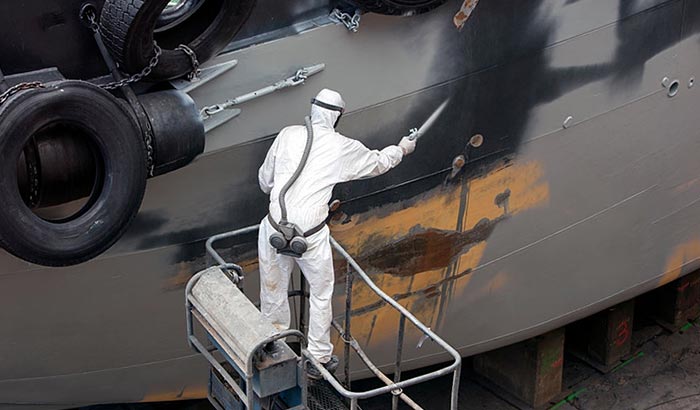
Many boat owners are frustrated with how their aluminum, steel, or even wood boat exteriors keep running into problems over a short amount of time. I bet that they have not found out the right item to coat on these types of material.
What if I tell you that you can have a brand new attractive paint color on the topside surfaces, combining with a strong layer against multiple risks? Get to know the best paint for boat hull for optimal boat restoration in this article.
1. TotalBoat Wet Edge Marine Topside Paint
2. duralux m735-4 marine paint, 3. kop-coat pettit paint splash zone a-788, 4. totalboat outdrive af antifouling paint, 5. interlux y404kit/1 epoxy primekote, 6. totalboat inflatable boat bottom paint, who is this for, factors to consider when buying a paint for boat hull, advantages and disadvantages of using paint for boat hull, care and maintenance, frequently asked questions, best paint for boat hull reviews.
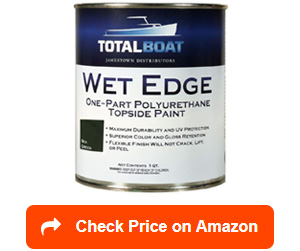
Should you ask me about the best overall marine paint for boat hulls currently available on the market, I will not hesitate to choose the TotalBoat Wet Edge Marine Topside Paint for providing this wide range of outstanding features.
Aside from 21 high-gloss paint color variations, there are also some flat finishes for your choice. You might be concerned about discoloring or fading over time, but its formula makes sure the paint will deliver superior adhesion.
Its high resistance is impressive to fight abrasions and UV damages. Being flexible and resilient helps this item endure ever-changing conditions with no cracking or peeling; plus, enables its compatibility with non-skin additives.
The Wet Edge paint is suitable for a variety of surfaces like wood, fiberglass, metal, etc. As long as you use the paint above the waterline, it will dry quickly regardless of your application method (rolling, brushing, tipping, or spraying).
You only need to apply from 2 to 3 thin paint coats on a surface to achieve long-lasting shine. The 1-part aluminum hull paint is easy to use and offers an uninterrupted flow with the incredible durability of a 2-part polyurethane.
That is why you can even paint the house with this marine-grade formula due to its powerful blockage against tough conditions. It also works well with other types of exteriors such as canoe, camper, golf cart, kayak, even an RV.
In my opinion, this paint coverage of 350 to 400 square feet per gallon is enough to fill a wide surface in one dip. There are versatile liquid capacities for you to select in different regions worldwide, including quarts, gallons, pints.
You should not miss out on this information about its applicable temperature from 50 to 90°F as it plays an important role in helping the paint dry up on time. Any uses outside of this range will result in its failure to set completely.
- 21 paint shades in an adhesive formula
- UV, abrasion-resistant for better endurance
- Allows different methods of application
- Easy to use with thin but durable coats
- Suitable for versatile types of exterior
- Requires the right temperature for drying
This boat hull paint manages to offer an amazing amount of protection that all boaters desire to equip their transportation. I would definitely recommend trying the durable all-in-one TotalBoat Wet Edge Topside Paint at least once.
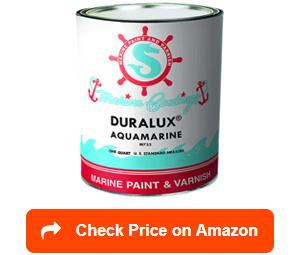
DuraLux M735-4 Aquamarine Boat Paint is a premium boat hull protection paint with properties for commercial and pleasure boats, now developed to work with all types of marine maintenance applications on and offshore.
Remember that as long as the targeted surface is properly primed in the first place, this type of marine paint will provide an excellent level of adhesion to a variety of popular surfaces, including aluminum, fiberglass, metal, and wood.
The best news about this product is how it can endure repeated washing and does not discolor under the harbor gas effect. It also resists UV radiation, gasoline, oil, chemicals, as well as saltwater with no further surface rusting.
The base paint material is acrylic and it is the most important feature to help it achieve solid transparency and a high gloss sheen. Feel free to combine it with a roller, paint sprayer, or brush as desired for flexible applications.
In terms of after-paint drying, the liquid needs at least 240 minutes to reach the dry-to-touch condition without smudging all over the place. You should perform the next recoat after 24 hours to ensure the best performance.
In spite of having a relatively limited coverage area of 125 square feet per gallon compared to many other available painting products, I believe that you can still spread the paint evenly on topside marine and boat structures.
However, there were certain cases of the paint spilling out on arrival and led to a significant amount of content shortage. This is probably because of its unprotected can that could not hold up to external pressures during delivery.
- Works for on/offshore marine applications
- Can be used on a variety of surfaces
- Multiple resistance without discoloring
- High-gloss finish with solid transparency
- Does not take much time to dry up
- Flimsy container results in content spill
Other than the fragile container that requires a serious construction upgrade, DuraLux M735-4 Aquamarine Boat Paint can still provide a great level of exterior protection for your favorite boat that dries quickly without discoloring.
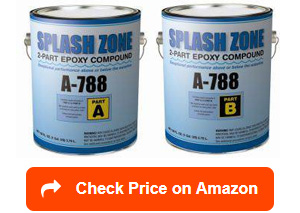
Have you ever wondered why the Pettit Paint Splash Zone A-788 is called “The duct tape of the marine world”? I will introduce its multi-purpose features to prove to you that this compound is the most versatile surface amendment.
Its formula contains 2 parts of epoxy patching mixed with an effective repair compound to provide excellent underwater damage repair. It is also flexible for above and below waterline use to fix buoys, docks, sea walls, boat hulls, etc.
You would certainly enjoy how the product performs multiple types of repairment with its putty-like formula: filling, sealing, patching, re-building on diverse surfaces such as fiberglass, steel, wood, aluminum, and concrete.
If you are worried about metal boat corrosion through frequent submergence in saltwater, it will produce a protective surface that is rock-hard. The good news is that the marine paint also prevents concrete and wood deterioration.
As boat owners obtain a newly painted solid layer, they will be able to either tape, drill, and even machine through this powerful surface. That is why this paint is widely known as an effective repairment for damaged boat exteriors.
Based on my experience, it appears that this item does slow down the leak inside your boat, but its effect is not the best possible. The water would not stop completely so I do not think that its sealing ability has a fine performance.
- High versatility for multiple purposes
- Effectively repairs diverse marine parts
- Enables amendment on different surfaces
- Eliminates metal, wood, concrete corrosion
- Helps coat a strong, protective layer
- Blocks water leakage but not the finest
Without a doubt, the Pettit Paint Splash Zone A-788 is one of the most excellent amendments you can get to fix boat damages. Besides the regular corrosion-proof for metal, it also prevents wood and concrete deterioration.

Looking for a marine-grade bottom paint that is antifouling for your propeller, outboard, outdrive, and boat hull? Try the Outdrive Antifouling Paint from the famous manufacturer TotalBoat and be amazed at its impressive abilities.
While many conventional antifouling paints containing cuprous oxide cause underwater metal components to corrode, you can rely on this copper-free formula with organic biocide for boatyard use under environmental limitations.
Thanks to this safe, natural ingredient, this antifouling product promises that no algae, barnacles, or slime growth can develop within its application. This protection is full-season use below the waterline in either salt or freshwater.
I appreciate how boat owners can use 3 different methods to coat the paint on their selected surface, including rolling, spraying, and brushing it. Its fast-drying feature at 90°F allows you to use the surface at least 2 hours later.
There is a wide range of surfaces for you to apply this outdrive product on, such as properly primed iron, aluminum, steel, and even underwater metal. Its smooth eggshell finish is polishing and durable enough for long-term use.
You can get a 1-quart container of black paint for one purchase. The paint coverage is approximately 125 square feet per quart, which is an average rate with 1.5 mils of dry film thickness. I bet that the final results would be great.
Unfortunately, I encountered a huge blob of solids at the bottom of this can from the beginning and spent nearly an hour trying to break it up. Therefore, I guess its content should be completely mixed (broken up) to be effective.
- Offers an antifouling coat for boat hulls
- Copper-free formula with organic biocide
- Full-season protection from slime, algae
- Dries up quickly after at least 2 hours
- Provides a sleek finish on multiple surfaces
- The bottom solids have to be broken up
It is true that having a protective coating from UV rays and material corrosion for your boat is necessary, but sealing it against algae and slime is equally crucial with TotalBoat Outdrive Antifouling Paint and its quick-drying feature.

Apart from optimal topside boat paints in this article, I would like to present you with an effective priming product for better surface preparation as well – the multi-purpose Interlux Y404KIT/1 Epoxy Primekote in a bright white shade.
Its main formula contains epoxy to be applied to form a solid base for 2-part finishes, especially for topside paint systems containing polyurethane from the same brand. Moreover, this paint also performs well for single-part enamels.
When you apply this primer over clear epoxies, it can eliminate the annoying adverse effect of amine blush. The main reason why I always choose the product for bilge and locker areas is because of its bright white paint finish.
From my perspective, adding a priming layer is a crucial part of the system because it is able to resurface crazed and cracked gel coats before you apply a topside paint. The item helps you prepare this surface properly in advance.
What I enjoy the most about priming this product on my boat exterior is how it sands at ease with a great level of adhesion to clear epoxy, together with a large number of surfaces including fiberglass, steel, Gelcoat, and wood, etc.
The best thing is the primer only takes about 1 to 3 hours for complete drying to touch. It is possible for you to recoat the applied surface at least 8 hours later in 73 F, and the most effective overcoat timing ranges from 6 to 12 hours.
If you choose to prime any of the mentioned surfaces above the waterline, I would recommend 1 to 2 coats. However, underwater use will require more sustainability so opt for 6 coats for it to stick longer under such conditions.
Lastly, there are different coverage dimensions available with 450 square feet per gallon for brush and 375 for spraying this paint. It will be sold in a kit with a capacity of either a quart or a gallon to perform for diverse painting projects.
I must say that I have not discovered any serious problems related to how the 2-part primer works. It fills imperfections quite brilliantly on many surface types, sands good then stick onto the targeted layer better than expected.
- Delivers a solid base for 2-part finishes
- Reduces amine blush on clear epoxies
- Can resurface a damaged gel coat
- Versatile capacities for different projects
- No defections have been found so far
Interlux Y404KIT/1 Epoxy Primekote provides an incredibly solid base for any of your marine painting projects. Kick off with this effective primer prior to your topside paint on multiple surfaces, and you will receive a great adhesion level.
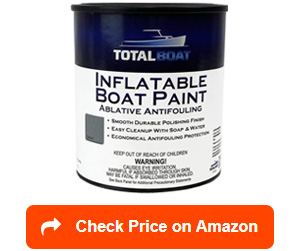
The last sailboat hull paint on this list is the only product with a water base – TotalBoat Inflatable Boat Bottom Paint. It provides an ablative antifouling layer for inflatable boats of diverse materials, such as PVC, rubber, and Hypalon.
With its smooth polishing finish that is extremely durable regardless of the surrounding conditions and an attractive, neutral gray shade, I believe this paint will look stunning on all mentioned materials of an inflatable marine boat.
From my perspective, using water-based paint for boat hull has its very own benefits. The product does not contain any harmful fumes or solvents and is incredibly easy to wash away with soap in case of undesirable applications.
Although this bottom paint contains 25% copper in the formula, your inflatable marine transportation will attain a strong repellent from algae and barnacle growth in both salt and fresh water, using the item to coat a protective layer.
Moreover, you will notice how the copper ingredient wears away at a controlled rate over time. This feature is beneficial to maintain the antifouling protection coating for any selected surface of every kind all season long.
The flexible coating is durable enough for you to deflate or roll the boat up without cracking or lifting from this applied surface. You can compare it with other similar products and still find the item a brilliant invention for inflatables.
There is no specific restriction for its normal launch time but you should better wait for 6 to 10 hours, depending on the temperature conditions. It will take around 3 hours for the inflatable bottom paint to fully dry to touch at 70° F.
Despite being stored in a sturdy container, I am deeply disappointed how the paint came really clumsy. Furthermore, there is a high chance that this content may dry out from sitting on the shelf for too long, costing more time to remix it.
- Durable, smooth finish for inflatable boats
- Easy-to-wash safe water-based formula
- 25% copper blocks algae and barnacles
- Does not crack when rolling up the boat
- No specific restrictions for the launch time
- Possess a great risk of drying out on-shelf
I am confident that you will never regret trying out this USA-made water-based paint for inflatable bottom coverage. TotalBoat Inflatable Boat Bottom Paint is an awesome product that includes what it takes to shield your boat effectively.
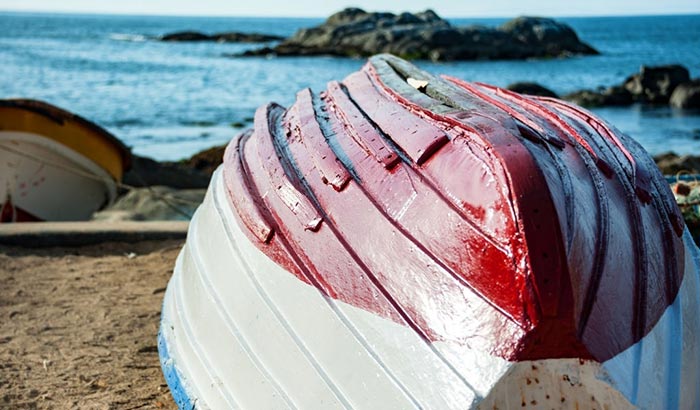
As an effective product for topside boat coating regardless of the surface materials, it is most suitable for boat owners who wish to equip their marine transportation with better exterior protection or old damaged paint coverage
With so many products available on the market, which criteria should you rely on when buying this type of paint for aluminum boats? Here are important features that you should not miss out on to ensure making the best decision.
Applicable Areas
The first and foremost criteria that you should account for when buying paint for topside boat is its application areas. Other than boat hulls, it is possible for you to use this type of paint on buoys, docks, sea walls, etc.
Also, there is a wide range of surfaces that are compatible with the product such as metal, wood, fiberglass , aluminum , iron, and steel. They should be properly primed in advance with a fine primer for increased paint adhesion.
A few products can only be applied for surfaces above the waterline that undergo water submergence shortly, while other choices are able to work well either in brackish, fresh, or saltwater without losing the main effectiveness.
Quality Formula
Undoubtedly, the formula determines how well the boat hull paint performs. It is your choice to either choose organic ingredients or one with copper in the formula since each of them comes with a different benefit.
Its formula base also varies depending on your purpose of use. Many products with acrylic provide enhanced adhesion and saturation, while a water base does not contain solvents or fumes and is much easier to wash away.
With a quality topside boat paint formula, I can assure you that you will be amazed by its function to eliminate peeling, cracking, discoloring and stopping certain materials (metal, wood, aluminum, etc.) from immature deterioration.
Moreover, this formula will limit the strong growth of barnacles, algae, and slime on the applied surface. It also brings a powerful resistance to UV rays, saltwater, chemicals, rusting, and other thick liquids such as oil and gasoline.
Diverse Capacities
I highly appreciate the diversity when it comes to the container capacities of this marine boat paint. For one single model, you can have different capacity choices since it will be available in gallon, pint, quart.
The marine-grade paint will usually be contained inside a thick can for optimal storage regardless of the surrounding conditions. You just need to stir the content well, apply a thin layer of paint on a surface and spread it evenly.
Besides, remember that different coats are required for different use: 1 – 2 coats for using above the waterline, 5 – 6 coats to add more durability if your boat stays afloat often. Its coverage ranges up to 450 square feet per gallon.
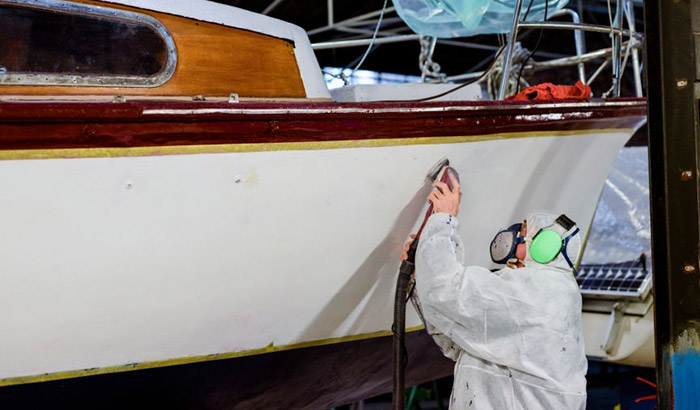
Advantages:
- Provides a protective marine-grade coating
- Adaptable to a variety of different surfaces
- Suitable for diverse boat area applications
- Offers a wide range of saturated colors
- Creates a smooth, durable polishing surface
- Enables resistance against versatile factors
Disadvantages:
- May take too long to dry up completely
- Stiff content becomes frozen with ease
- Not enough thickness produced in use
- Stored inside a flimsy, unsealed container
- Requires priming the surface beforehand
Based on my experience, the most important thing when it comes to taking care of a marine paint container is to store it at normal room temperature. Stir the content sometimes to make sure it does not freeze in a cold season.
Out of all available choices, opt for a sealed and sturdy container because a flimsy one is likely to result in distortion and internal content spillage. Follow these rules of thumb and I believe that you will do perfectly fine with the paint.

How Often Should you Paint the Boat Hull?
As new users may wonder how often they need to repaint boat hull, it is ideal to apply this bottom paint once every year, though some products can last up to 2 years while still remaining effective to safely protect such a marine part.
Keep in mind that if your boat stays in the water or is being used on a regular basis, bring it to a professional for precise annual checkup. This routine will help you determine if the marine boat needs a new bottom paint application .
How to Spray Paint the Boat Hull?
There are many popular methods that you can use for painting a boat hull, including brushing, tipping, rolling, and spraying. Among these choices, my preference will go to using a sprayer to attain the most appealing results.
Some products will require thinning with xylene in advance to enhance the overall adhesion for a better finish. Remember that the thinning percentage varies by the sprayer and surrounding conditions, usually from 15 to 20%.
You should spread the paint evenly on the targeted surface to avoid applying it too thickly, or else the finish will not be able to dry properly. With a prepared surface in hand, I am certain that your spraying work will end up much better.
Using an effective marine hull paint will make sure you have a proper boat protection against harmful external impacts in the long run. There are multiple types of risks out there in the water waiting to damage your transportation.
What is your opinion on this article reviewing the best paint for boat hull on the current market? If you have not yet decided which product suits you the most, follow my buying guide for other good choices. Thank you for reading.
Leave a Comment Cancel Reply
Your email address will not be published. Required fields are marked *
Save my name, email, and website in this browser for the next time I comment.

IMAGES
VIDEO
COMMENTS
Your new paint won't adhere to the old paint as well as it would to the boat hull itself. Primer. Putting on a layer of primer is not 100% necessary but it is recommended. The idea is that you want your topcoat to adhere to the boat as well as possible, a layer of primer can help you do that. The primer needs to be painted on evenly all over ...
Preparing to Paint your Hull. When it comes to applying fresh paint, the three keys to success are the product, the preparation and the application. ... it seems something always needs painting. For boat owners, that's especially true. In preparation for writing this piece, I took stock of my paint arsenal. The roundup: 32 cans of various ...
Practical Steps for Painting a Sailboat. Step 1. Give the sailboat a thorough cleaning. Step 2. Start sanding the hull's surface. Step 3. Prepare the primer, then apply it. Step 4. Prepare the paint, then start applying the topcoat and antifouling coat.
The frequency of painting a sailboat depends on the type of paint used and the amount of time the boat spends in the water. Bottom paint, which protects the hull, should be applied annually. On the other hand, top paint, which adds color and gloss to the boat, can be done every 3 years.
Learn how to paint the bottom of your boat. Having a clean hull is crucial for your boat's performance, maneuverability, and fuel usage. These are the steps ...
Fill the basin of your paint tray with paint. Dip your roller, unload it on the tray slope, and roll it up and down on the hull, i.e. from waterline to keel. Work fast as many bottom paints dry quickly. Each time you refill the paint tray, first stir the paint in the can to keep the copper in suspension.
Particularly useful for painting the hull and larger areas. 5. Detail brushes: Perfect for adding intricate details and highlights. Allows for precise control in adding fine lines, textures, and highlights. Fact: Using the right brushes not only makes painting a sailboat easier but also enhances the overall quality of your artwork ...
After months of fairing and prep work, it's finally time to paint the hull of my sailboat. I'll be using International Perfection Pro. A paint that can be ap...
Step 6 - Paint. Once you've created a strong base with your repeated sanding and priming, it's time to paint. Use a roller and paintbrush to color your boat hull with marine paint. Brush the hull carefully, especially on areas where bubbles form up. When the painting job is done, let your boat hull dry for several hours.
Prep the surface by washing, de-waxing, and thoroughly sanding it. Apply the primer, then the paint. Wax the boat from stem to stern to protect the new paint job. Then, simply keep it clean, and rinse it thoroughly after use in saltwater. Remember, before you paint a boat always read the warning labels on all of the supplies and be sure to use ...
Antifouling paint is poisonous to marine life and prevents it, as much as possible, from adhering to the bottom while the boat is in the water. Sailors early on recognized the importance of keeping the bottom of their craft free of fouling as a hull covered with barnacles and weeds loses significantly in terms of speed and performance.
How to Prepare a Boat's Hull for Painting. If you've been wondering how to prepare a boat for painting, there's no short answer. The reality is the actual painting of your boat takes the least amount of time — the preparation is the time-consuming part. However, with the right preparation, your coat of paint will last several years and ...
Apply primer, if necessary, and resand. Apply the finish paint with a partner, using roller and brush. Let each coat dry completely before lightly sanding for the next, laying on a minimum of two coats. Protect yourself and the environment. A smooth application of bottom paint helps boat performance.
Pour the boat paint into the tray and lightly dampen the roller with water. Immerse half the roller into the paint can and run it several times on the tray for even distribution. Paint the sailboat's hull, ensuring firm and even pressure. Maintain uniform strokes. Dip the paintbrush into the paint and remove excess pigment.
Proper preparation of your hull is the most important part of your topside paint job. It won't last or look good if you don't take all the steps necessary to...
If you lack these things, then maybe you should drop the idea to re-gelcoat the boat. If you leave the boat in the water for a long time (or maybe regularly), then we strongly recommend that you re-gelcoat the hull. Paint won't be as useful in this case. Re-gelcoat your boat's bottom if the old gelcoat is all worn out, and there's no way ...
David Singer at Rocky Point Boat Worx discusses how he preps a boat for a fresh coat of paint using the roll and tip method. After that the paint and top coa...
The boat's hull is a near-vertical surface, and multiple thin coats are preferred for painting it since the paint from a thick coat of paint can drip and spoil the painting. If the gelcoat on the hull is severely oxidized and has a chalky look, the oxidized outer layer will have to be removed.
Hiring an Expert for Hull Painting. It can cost anywhere from $500 to $3,000 to paint a sailboat hull, depending on the size of the boat and the type of paint used. If you hire a professional painter, they will typically charge by the hour or square foot. The average cost per hour is around $50.
Get this FULL SERIES here: https://www.offcenterharbor.com/yt-boat-paint-2204/Get a grip on how to paint a boat — before you head off to the marine paint sto...
Get to know the best paint for boat hull for optimal boat restoration in this article. Contents [ hide] Best Paint For Boat Hull Reviews. 1. TotalBoat Wet Edge Marine Topside Paint. 2. Duralux M735-4 Marine Paint. 3. KOP-COAT Pettit Paint Splash Zone A-788.